Your garden serves as your sanctuary, and having red flowers can add vibrancy and energy to your outdoor space. Red symbolizes love, passion, and excitement, making it an alluring choice for any garden. While you may already have red flowers in your garden, there are plenty of lesser-known varieties waiting to be discovered. Intense, scarlet blooms can be a stunning addition to any garden, whether scattered in between other plants or clustered together for a bold statement. In this detailed guide, we will explore a variety of red flowers that are perfect for your home or garden. Each flower has its own unique characteristics, offering a diverse selection to create a special atmosphere in every corner of your outdoor space. We’ll provide a brief overview of each flower along with some helpful tips on how to care for them. Let’s delve into the world of red flowers together!
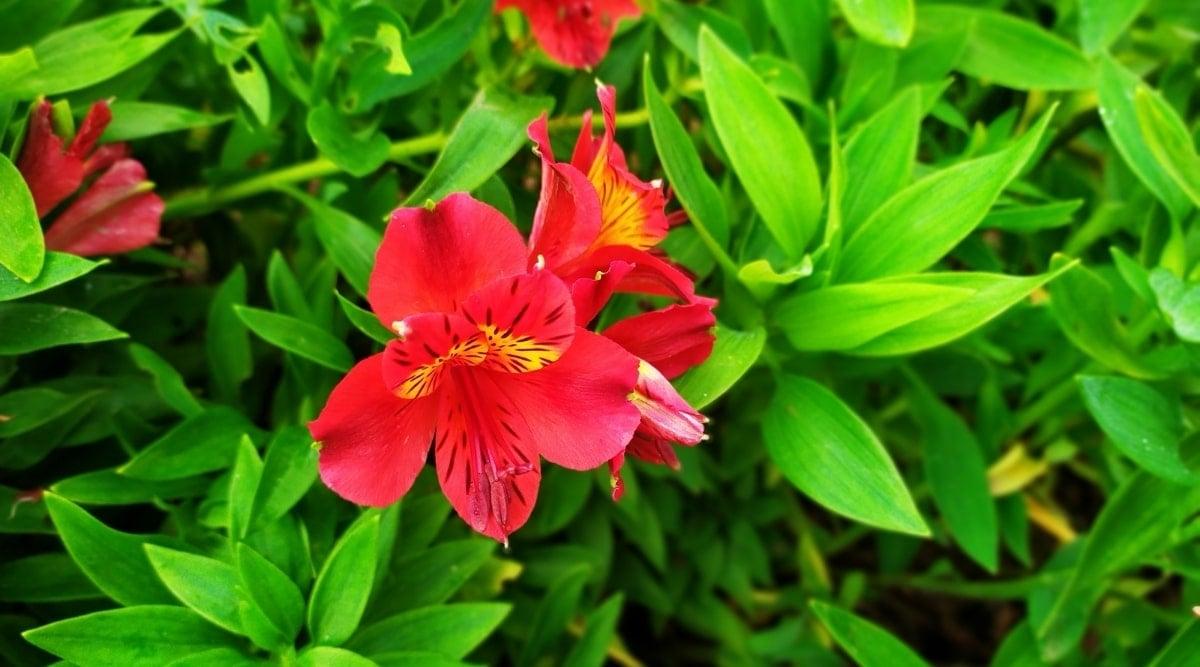
The Alstroemeria, also known as the Peruvian Lily, is a beautiful and exotic flower with bright red-orange petals, a golden throat, and deep burgundy streaks. Resembling a lily, this plant is hardy and vigorous, producing numerous flowers from late spring to late summer. Growing to a bushy 16 to 20 inches in height and 20 to 24 inches in width, Alstroemerias thrive in moist, well-drained, and fertile soil under full sun or partial shade. These flowers are easy to grow and maintain, making them perfect for casual gardeners. Alstroemerias can thrive in USDA zones 8 through 10 with a soil pH of 6 to 7.
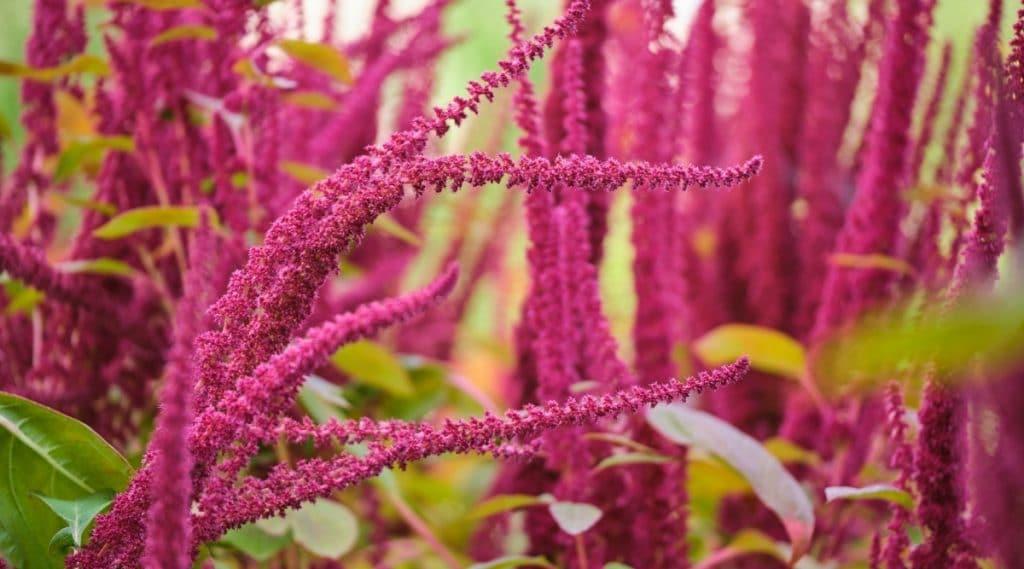
A unique and exotic way to add a pop of red to your garden is by planting the Amaranthus flower. This flower, native to India, Africa, and Peru, stands out with its long, rope-like blossoms that bloom a vibrant crimson red in the summer and fall. Its tassel-like clusters of florets create a striking contrast against its light green, oval leaves, making it a standout feature in any summer garden. Standing tall at heights ranging from 36 to 96 inches and widths of 12 to 36 inches, the Amaranthus is sure to make a statement in your garden. To ensure the Amaranthus thrives, it must be planted in full sun in fertile soil that is well-drained, moist, and rich with humus. While it can become drought tolerant once established, it does require some maintenance, such as cutting back after flowering as it easily propagates. This versatile plant can grow in USDA zones 2 to 11 and can adapt to alkaline, acid, or neutral soil pH levels.
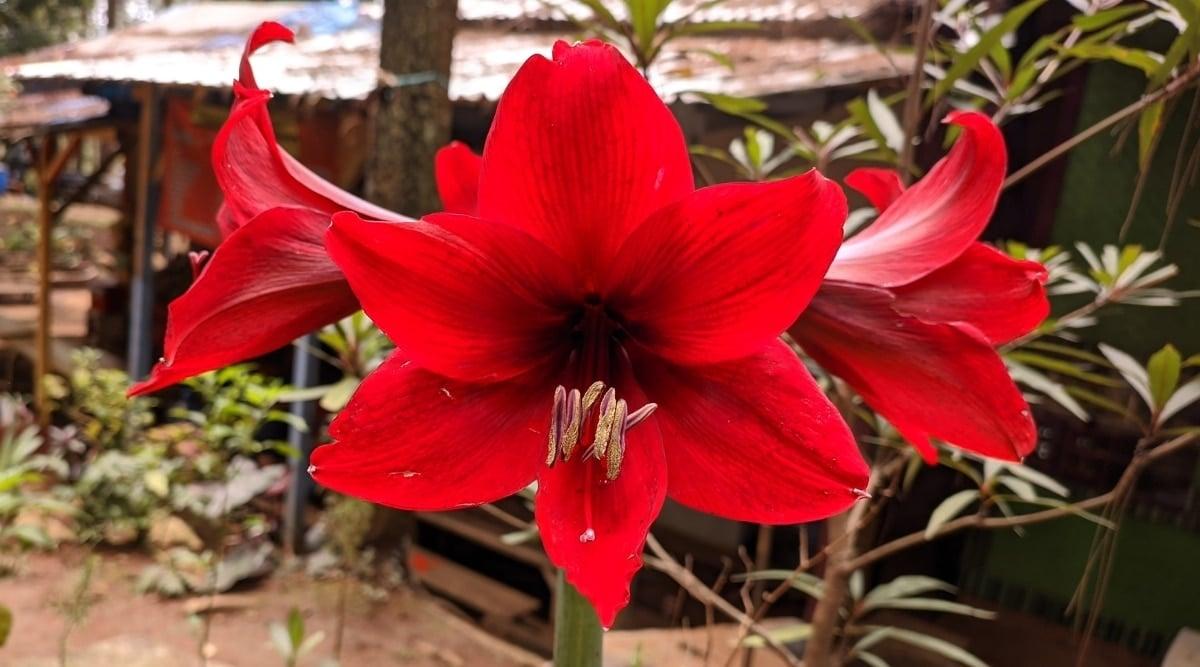
A popular choice for adding a splash of red to any garden, the amaryllis is a striking flower with large, regal petals. Known for its velvety texture and deep crimson hue, this flower is a real showstopper. Growing up to 20 inches tall from a single bulb, the amaryllis produces 2 to 3 stems, each with 5 to 6 gorgeous flowers. These blooms don’t all open at once, but instead flower gradually over time, creating a beautiful display. While the amaryllis is easy to grow and thrives in various soil types and USDA zones, it’s important to note that the plant can be toxic if ingested. As long as this precaution is taken, this stunning flower is a fantastic addition to any garden.

These vibrant and stunning flowers are sure to stand out in your garden. Known scientifically as Anemone, these blooms may not be related to the sea anemone in fish jokes, but the Anemone coronaria is still a cheerful sight with its double petals resembling poppies. While they may not last long, anemones remain a popular choice for gardeners due to their bright and inviting appearance that is easy to grow and maintain. Thriving in sunny areas with well-drained, sandy soil with moderate moisture, these flowers are ideal for beds, borders, rock gardens, or as a lovely addition to a floral arrangement. With their aversion to cold temperatures, anemones typically bloom in mid to late spring, attracting butterflies with their beauty. It is recommended to soak the small corms of the anemone in water before planting, as they can grow to be 8 to 12 inches tall in USDA zones 7 through 10.
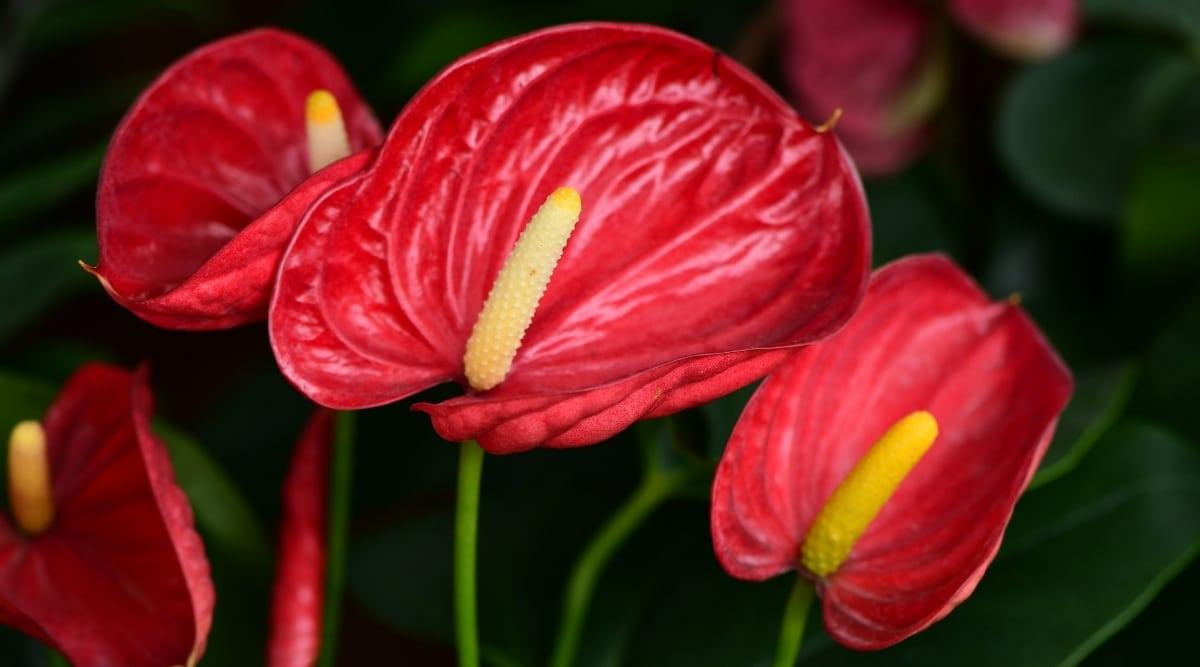
The anthurium, known by its scientific name Anthurium andraeanum, is a gorgeous flower that boasts a vibrant red color all year round. Its natural hue has earned it the nickname “flamingo flower” due to its pale rosy coloring that transitions into a bright, waxy red as it matures. With its heart-shaped spathe and white or cream-colored spadix, the anthurium also showcases stunning variations in bright yellow. The entire flower appears glossy, almost as if it has been coated in lacquer or varnish, and can reach impressive heights of 12 to 18 inches with a width of 10 to 12 inches. In ideal conditions, the anthurium can thrive as a long-lasting flower that blooms consistently throughout the year. When planted indoors in a container filled with a soil mixture containing peat and other organic substances like compost or ground bark, these plants can be expected to produce 4 to 6 flowers annually. Anthuriums require filtered light, regular watering, and a constant temperature of 16 degrees Celsius, with higher humidity levels during the summer months. They flourish best in USDA zones 11 through 12.
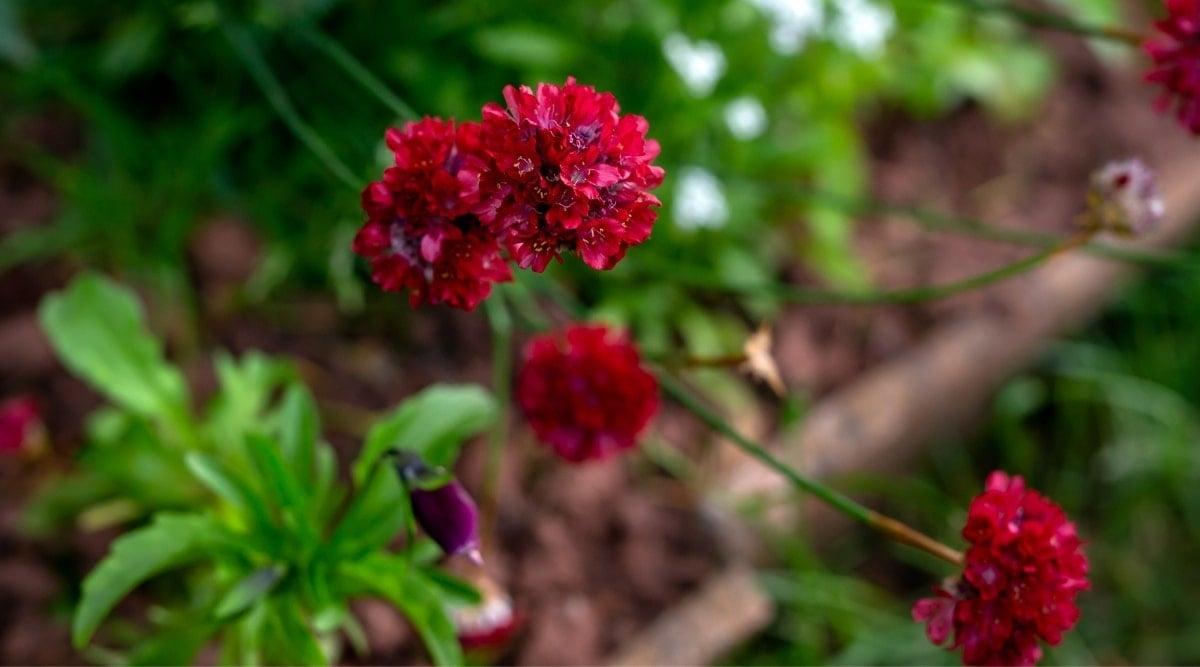
The flower known as Ballerina Red, scientifically named Armeria maritima, is recognized for its beautiful spherical blooms. These blooms, made up of densely compact florets, are a bright shade of red and can transform any garden with their charming appearance. Blooming in mid to late spring, Armeria continues to blossom sporadically throughout the summer and fall. This lovely flower is easy to grow, even in dry and infertile soil. When planted in richer soils, the leaves may fall outwards, leaving an open center. Armeria can thrive in both partial and full sun, and once established, it becomes quite drought resistant. Reaching a height and width of 8 to 10 inches, Armeria should be spaced about 10 to 15 inches apart from other flowers. With multiple blooms per bush, deadheading can promote another flush of flowers. This flower thrives in USDA and heat zones 6 to 7.
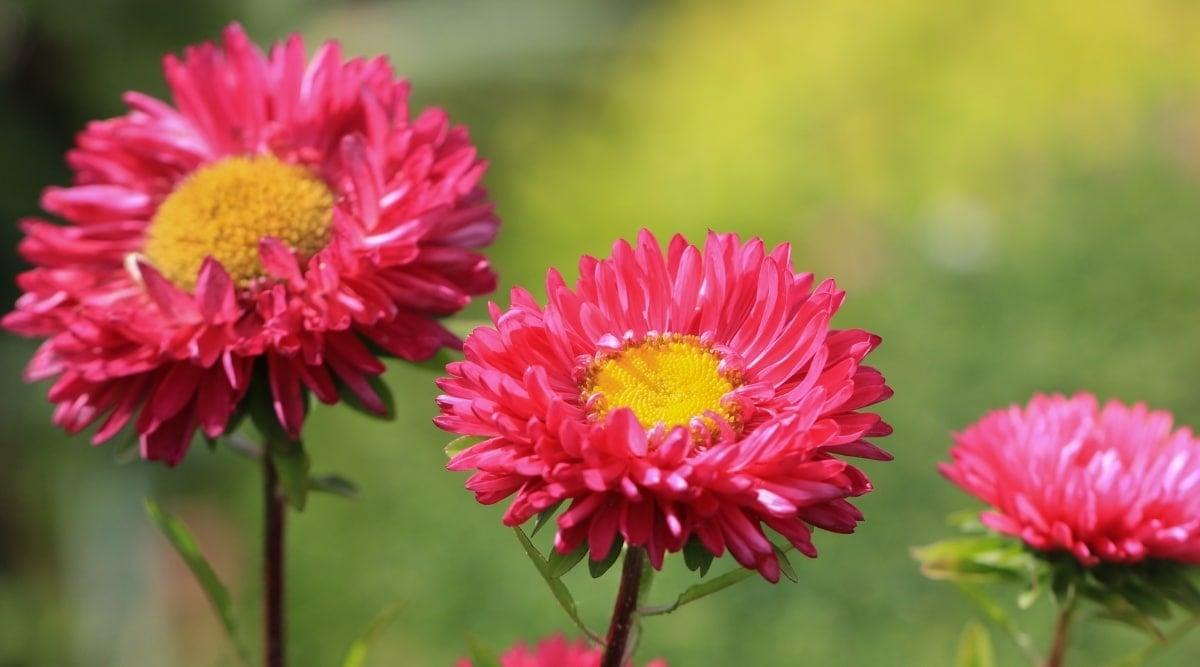
These Aster flowers, resembling daisies, come in various colors, with one of them being a striking ruby red shade. Known scientifically as Aster, this beautiful bloom is also known as Royal Ruby due to its rich mulberry-red petals and deeper red hue around its vibrant yellow-gold center. Originally from North America, the Aster blooms from late summer through early fall, bringing a cheerful vibe to any garden with its captivating look. It’s a favorite among garden enthusiasts looking to attract birds and butterflies, as these creatures enjoy the sweet nectar of the Aster. Asters are resilient plants that thrive in full or partial sunlight. They prefer well-drained soil with moderate moisture levels and good air circulation to prevent powdery mildew. These plants grow in an upright, bushy manner, reaching heights of 18 to 20 inches and widths of 12 to 18 inches. With a hardy nature, Asters can flourish in USDA zones 4 to 8.
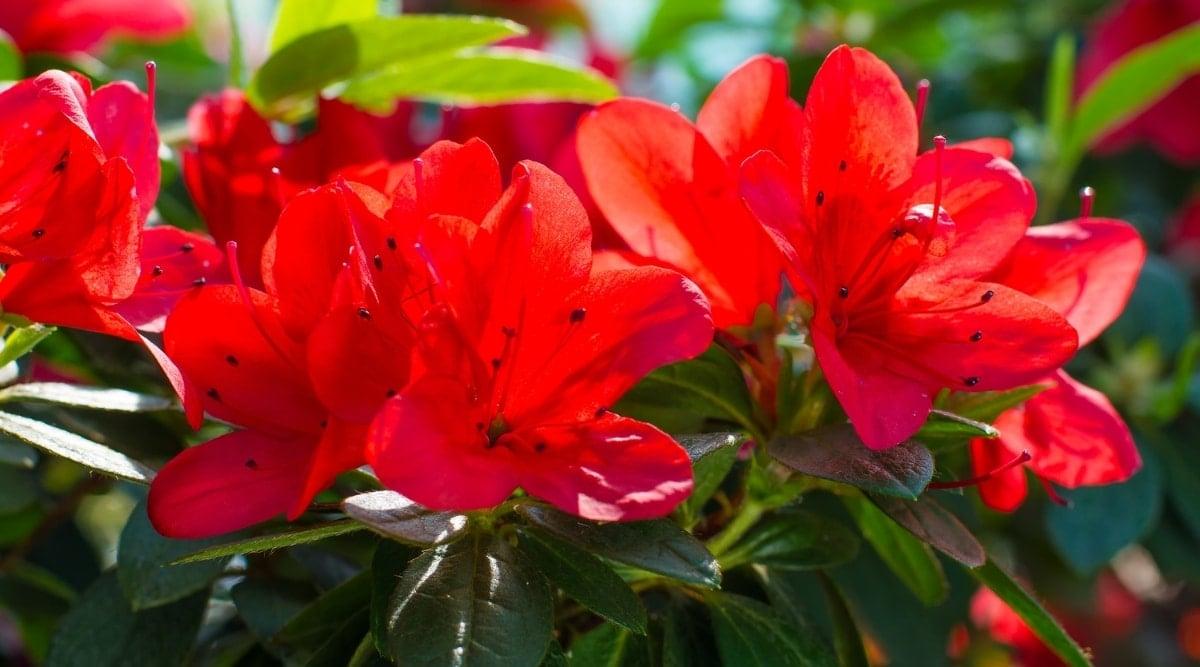
The vibrant Rhododendron, also known as the Flame Azalea, showcases a stunning array of fiery colors from golden-yellow to red with orange accents all in one bloom. The buds resemble small candle flames and unfurl into a beautiful star-shaped flower. While toxic to humans, these flowers are a favorite among birds like hummingbirds and butterflies making them a perfect addition to butterfly gardens. To thrive, Azaleas need full or partial sun, acidic well-drained soil rich in humus, and a layer of mulch to keep the soil cool and moisture retained while keeping weeds at bay. They grow into upright, spreading shrubs reaching heights and widths of 48-96 inches and should be planted in USDA zones 5-8 during spring, summer, or fall.
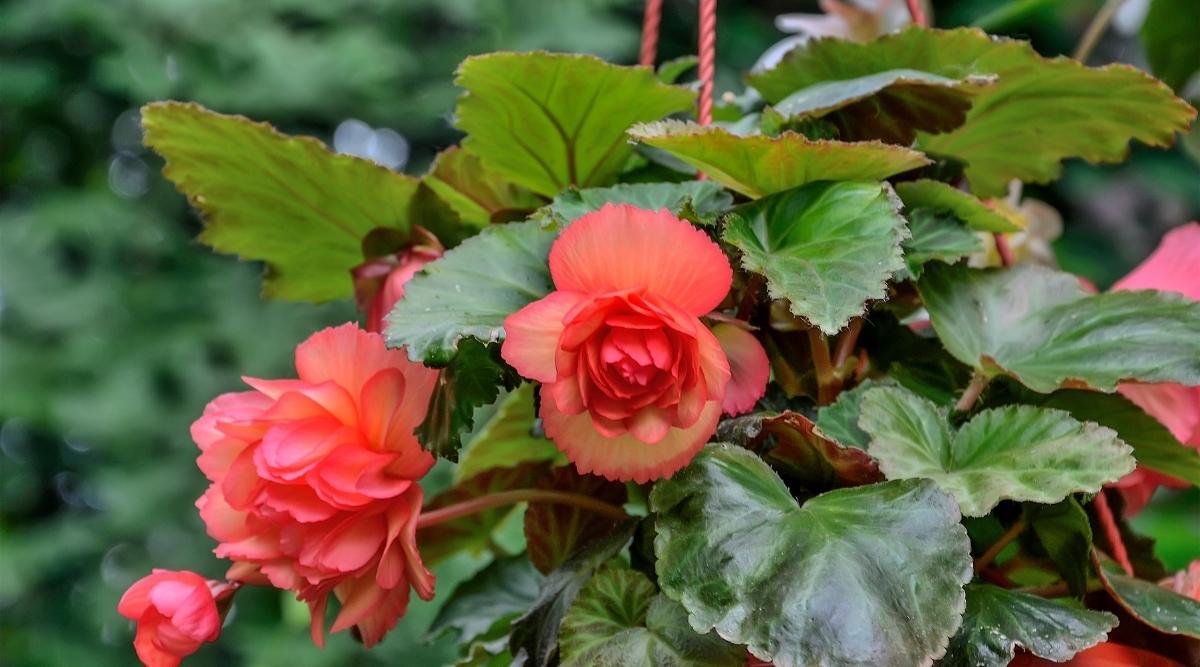
Scarlet begonias are a great choice for adding a pop of red to your garden with minimal effort. These beauties, scientifically known as Begonias, bloom consistently with large, vibrant flowers that closely resemble carnations. The scarlet-red petals are uniquely ruffled and crimped, standing out against the deep green, waxy foliage. These low-maintenance plants thrive in well-drained, fertile soil with a slightly acidic or neutral pH level, and prefer some shade from direct sunlight. They are resistant to deer and rabbits, making them an ideal addition to any garden. Scarlet begonias typically grow to be around 12 to 14 inches tall, spreading out 12 to 16 inches wide without much intervention. However, these delicate flowers are not suited for strong winds, cooler temperatures, or frost. Proper air circulation is important for their growth, and they should be dug up and stored in a dry place during the winter months. Scarlet begonias are best suited for USDA zones 9 through 11 due to their sensitivity to harsh weather conditions.

Known for their vibrant red blooms, these flowers are affectionately known as Cherry Pops and belong to the Monarda family. Bergamots are eye-catching, perennial plants that produce dense, cherry-red flowers in compact clusters. Their attractive appearance makes them perfect for informal garden borders, attracting butterflies and hummingbirds while repelling deer and rabbits. These plants thrive in well-drained soil with moderate fertility, enjoying either partial shade or full sun. Proper aeration is important to prevent powdery mildew. Bergamots can reach up to 20 inches in height and 26 inches in width, creating beautiful clumps of upright stems. Regular deadheading will promote continuous blooming and the flowers also make lovely cut arrangements. Bergamots are moderately resilient and do best in USDA zones 4 to 8.
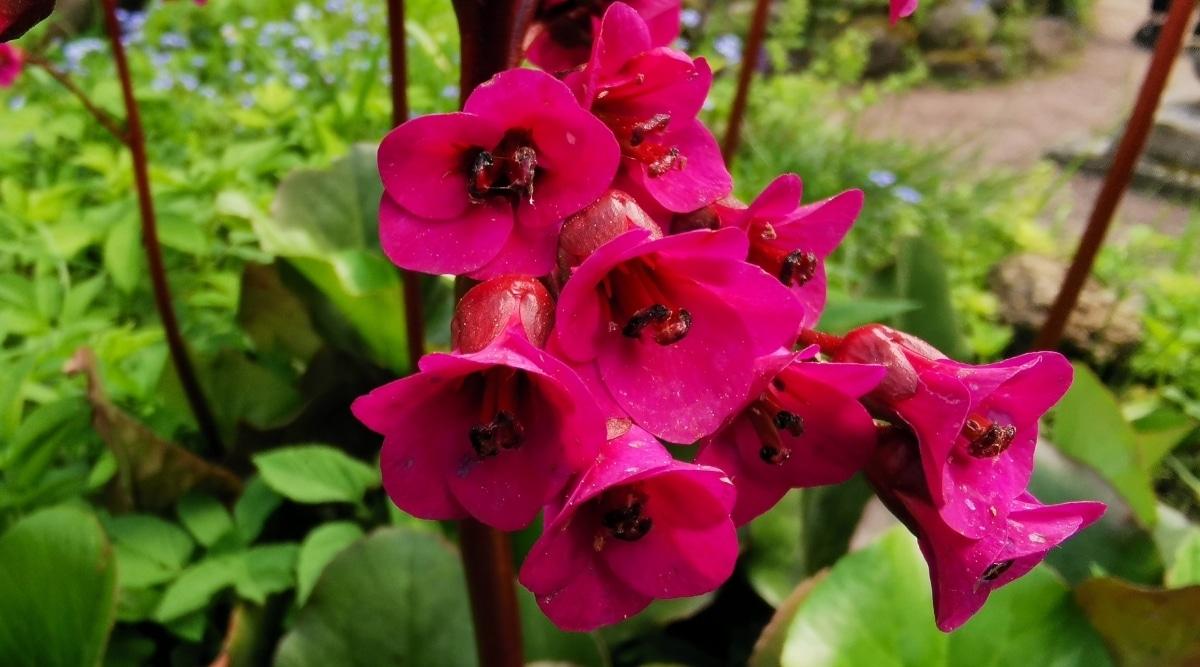
Bergenia flowers, also known as Evening Bells due to their bell-shaped appearance, are a beautiful winter plant that features clusters of rosy-red flower heads on upright stems. These flowers bloom from a sturdy, deep burgundy-red base that has a unique wrinkled and leathery texture. They are adaptable to various soil conditions but thrive best in average, moderately moist, well-drained soil that is rich in humus. Bergenia can grow well in full sun, partial sun, or even shaded areas as long as the temperatures are not too hot or dry. These plants are easy to care for and can be propagated through division or root rhizomes in the spring or fall. They are perfect for urban or coastal gardens as they are resistant to diseases and make for excellent ground cover along pathways. When planted in groups, bergenias create a stunning display. In USDA zones 4 to 8, they can grow up to 12 to 18 inches tall and wide. In conclusion, bergenia, or Evening Bells, are a beautiful and low-maintenance plant that can thrive in a variety of conditions, making them perfect for gardeners of all skill levels.
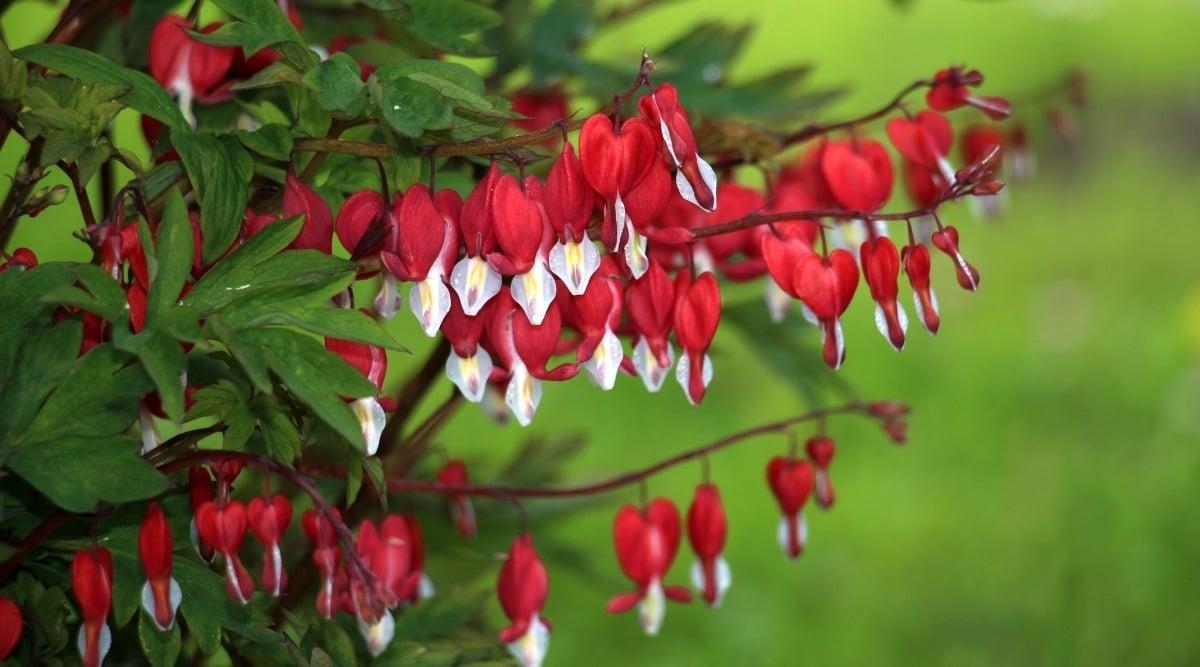
These beautiful heart-shaped flowers are sure to steal the show in any garden they’re planted in. Known scientifically as Dicentra spectabilis, the bleeding heart, aka the “Valentine,” has a truly magical appearance. This perennial plant features numerous arching flower stems, each adorned with scarlet-red heart-shaped blooms accented with white petals. Blooming for 4 to 6 weeks from late spring to early summer, these flowers eventually fade away, leaving behind lush green foliage. Bleeding hearts can reach heights of up to 30 inches and spread out just as wide. They thrive in well-fertilized, humus-rich soil that is well-drained, although they can also tolerate a bit of waterlogging. These plants do well in both shaded and full sun areas, as long as the soil remains consistently moist. They are most successful in USDA zones 3 to 9, but beware – these lovely flowers can cause discomfort if consumed.
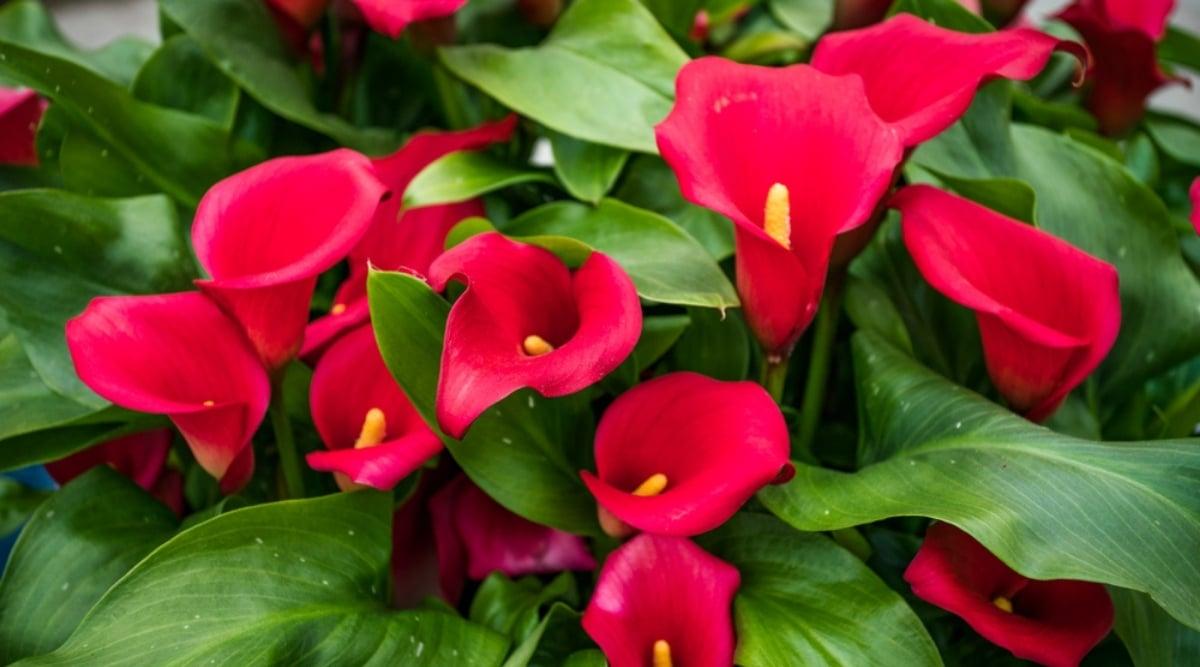
Calla Lilies, scientifically known as Zantedeschia aethiopica, are low-maintenance plants that can be grown in a garden or in a container without much hassle. Originating from South Africa, these vibrant flowers add a bold and cheerful touch to any garden during the summer and fall seasons. Calla lilies are known for their unique trumpet-shaped flowers that start off as golden-yellow and mature into a fiery orangish-red with yellow speckles. They also come in other colors like white and a striking deep black. Growing to a height of 14 to 18 inches and a width of 12 to 24 inches, these elegant flowers are a popular choice for weddings and bouquets due to their graceful appearance. They require moist and well-drained soil, thriving in either full sun or partial shade. While they are deer and rabbit resistant, it’s important to handle them with care as the sap can cause irritation to the skin and eyes and should not be ingested. Calla lilies thrive in USDA zones 8 to 10, making them a suitable choice for beginner gardeners looking to add a touch of elegance to their outdoor space.
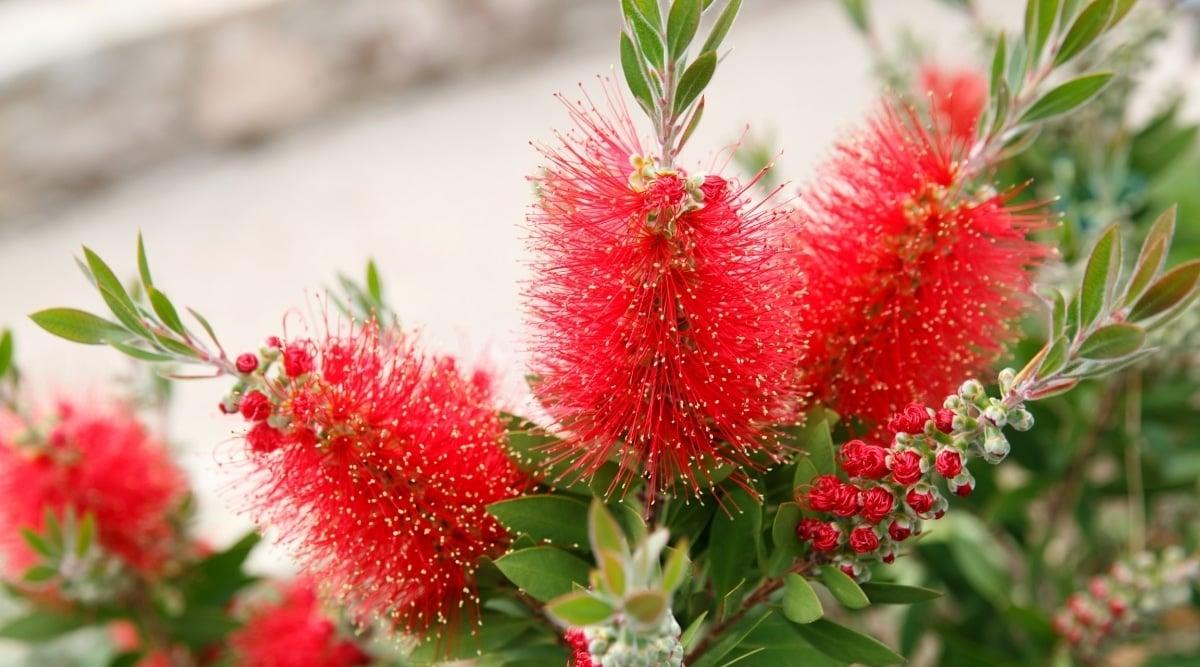
These vibrant flowers are commonly known as Crimson Bottlebrush due to their unique bottlebrush-like appearance. Scientifically named Callistemon, these plants are not only visually appealing but also emit a delightful fragrance that attracts birds and butterflies with their abundant nectar. When their leaves are crushed, they release a refreshing lemony scent. Propagated through seeds or semi-hardwood cuttings, Callistemons are evergreen shrubs that bloom striking crimson flowers with brush-like thistle petals. For optimal growth, these plants prefer moist, acidic soil that is well-drained, along with regular watering and plenty of sunlight or partial shade. Generally, they are resistant to pests, although they may attract spider mites, mealybugs, and scale insects if grown indoors. In their natural habitat of Australia, these plants can reach towering heights of 25 feet and spread up to 22 feet wide. Thriving in USDA zones 10 to 11, Callistemons are a fantastic addition to any garden or landscape.
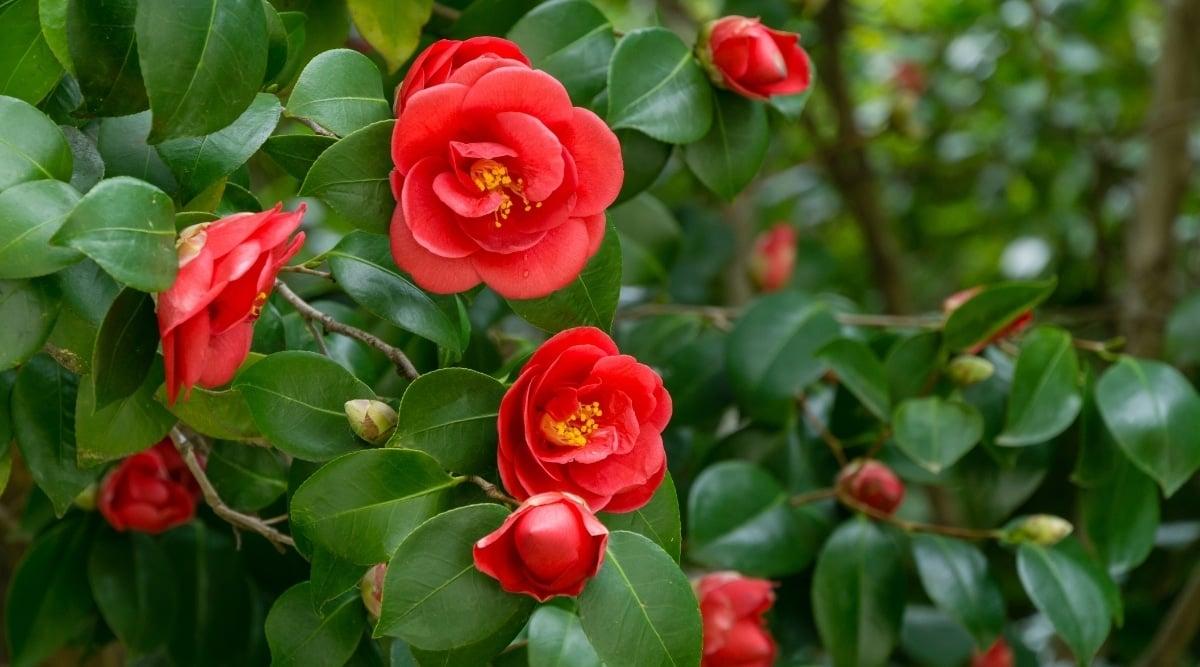
The vibrant and diverse camellia flowers are a year-round beauty, known scientifically as Camellia japonica. With over 30,000 different varieties, these flowers come in a wide range of colors and shapes. Among the favorites are the striking red camellias, which feature large, densely packed blooms in a deep red hue with golden stamens peeking out from their ruffled petals. These semi-double flowers bloom profusely for several months, creating a stunning garden display from spring to winter. Camellias thrive in acidic, nutrient-rich soil that drains well and retains moderate moisture. They prefer sheltered spots with partial or full shade, as they are not fans of direct sunlight. While these flowers are low maintenance, they do need protection from sunlight and common pests like vine weevils, aphids, and scale insects. In USDA zones 7 to 9, camellias can grow up to 6 to 8 feet tall and wide, adding beauty and charm to any garden.

The tropical canna flower, scientifically known as Canna, is available in various colors, including a striking red variety. Referred to as the “Ambassador,” this plant boasts an impressive appearance, growing up to 5 to 6 feet tall and spreading 18 to 24 inches wide. Resembling irises, it produces large, eye-catching flowers in vibrant hues. The lush emerald green foliage perfectly complements the velvety flowers, creating a stunning visual display in any tropical garden. Cannas are low-maintenance and easy to cultivate, thriving in various soil conditions. They prefer full sun and organic-rich, well-drained, and moist soil to flourish. While generally unaffected by pests, it’s essential to watch out for slugs, snails, Japanese beetles, and caterpillars, as they can cause significant damage to the leaves. It’s important to note that cannas are not frost-resistant and are best suited for USDA zones 8 to 11.
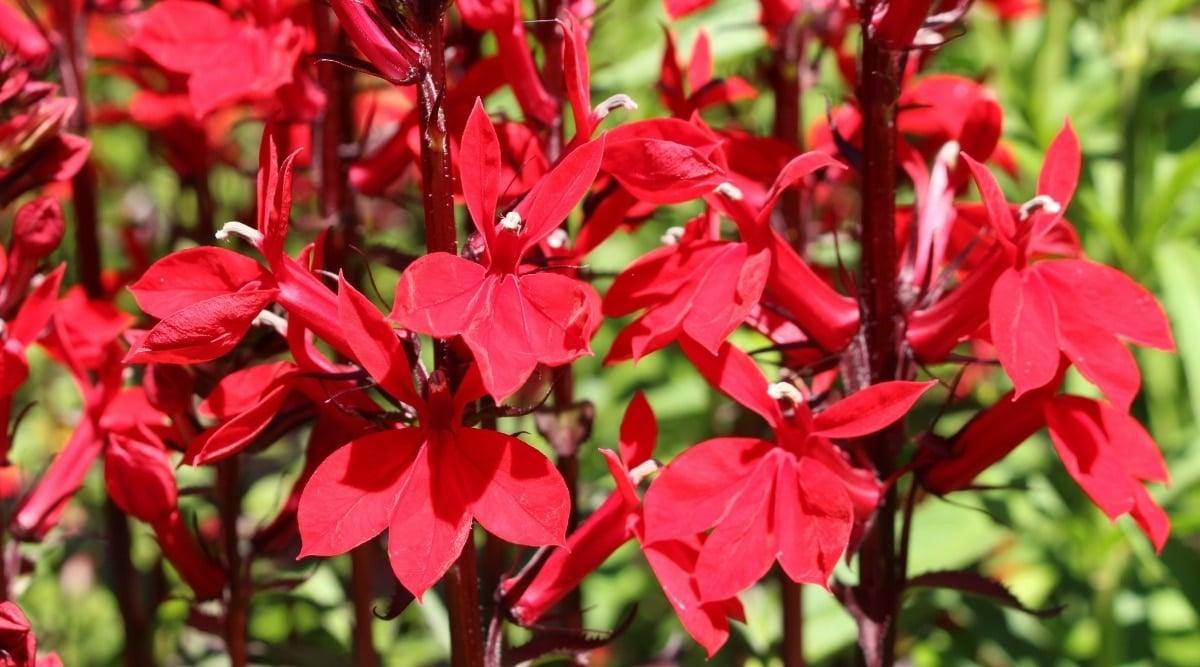
These vibrant and stunning cardinal flowers are a magnet for pollinators in any garden setting. Known scientifically as Lobelia cardinalis, the Queen Victoria or cardinal flower is a perennial that bursts with clusters of densely-packed, fiery scarlet-red florets. Though not a long-lasting plant, it reproduces through self-seeding under the right conditions. Thriving in rich, moist soil with full sun or partial shade in hot climates, these flowers can reach heights of 3 to 4 feet and spread 1 to 2 feet wide. Ideal for summer and wild gardens, cardinal flowers are a favorite among hummingbirds, bees, and butterflies, while simultaneously deterring deer and rabbits. Despite their delicate appearance, these flowers are resilient against drought and poor drainage, making them a great fit for USDA zones 3 to 9.

Here are some of the most popular flowers found worldwide. Known scientifically as Dianthus caryophyllus, carnations are beloved by many people across the globe. They are commonly given as gifts year-round, but are especially popular for Mother’s Day or as part of wedding bouquets. With their romantic, frilled petals and diverse color range, carnations are a lovely addition to any garden. Blooming in beautiful shades of red, carnations can brighten up flower beds or be used as cut flowers. When fully grown, they reach heights of 12 to 18 inches and are perfect for adding color and drama to less vibrant areas in your garden. They are relatively easy to cultivate. Carnations thrive in full sunlight and produce the most blooms when exposed to ample sunshine. However, they can also tolerate partial shade, particularly if the location receives bright afternoon sunlight. Morning sun is ideal for these flowers. For optimal growth, carnations prefer alkaline soils that are well-drained to prevent root rot. Ensure that you water your carnations regularly during spring, increasing the frequency slightly in the summer months. Once established, carnations can withstand dry conditions fairly well. They flourish best in USDA hardiness zones 7 through 10.
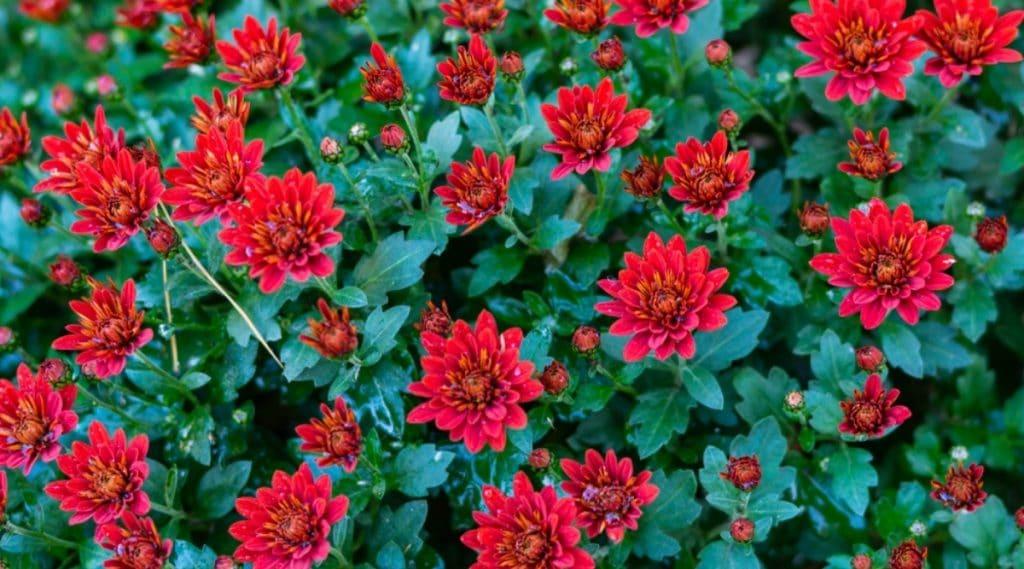
Mums, short for Chrysanthemums, are a beloved flower choice for the autumn season. Known scientifically as Chrysanthemum and affectionately as “Jolly Cheryl,” these flowers exude warmth and cheer. With their double blooms sporting a rich, red gradient that intensifies towards the center, they are a must-have for any fall garden. Blooming from mid to late fall, mums are not only popular in flower arrangements but also make for stunning cut flowers that can be used in various displays. These perennial plants form bushy, compact mounds that typically grow to heights and widths of 12 to 24 inches. Easy to care for, mums thrive with just average effort. They prefer full sun and well-drained soil enriched with organic matter, making compost a beneficial addition to their care routine. Regular watering is essential, and it’s advisable to protect them from strong winds. Mums flourish best in USDA zones 7 to 9, making them an ideal choice for many gardeners.
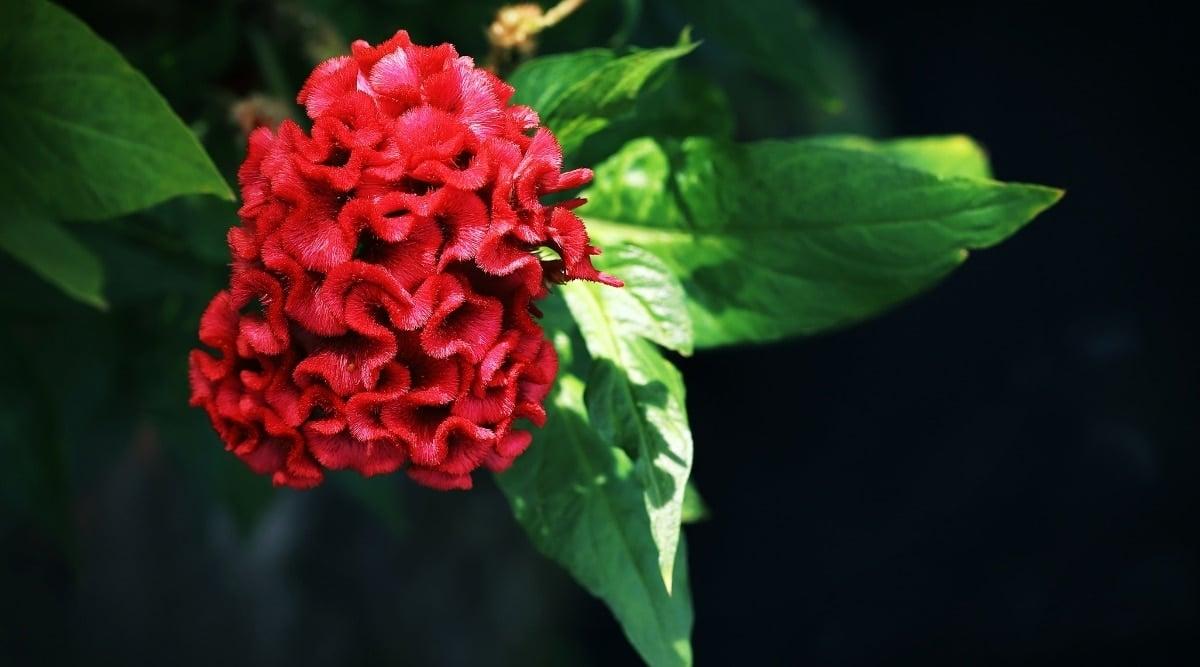
The vibrant red hue of the cockscomb flower pairs perfectly with its unique, velvety texture. Known scientifically as Celosia, these flowers get their name from their resemblance to a rooster’s comb. Available in an array of colors, including the striking red that pays homage to their namesake, these large blooms are versatile and can be used in wreaths and floral arrangements once dried. Their distinctive shape makes them a must-have addition to any garden. Cockscombs thrive in full sun and prefer moist soil with a neutral to slightly acidic pH level. Adding compost to the soil can help promote healthy growth. Good drainage is crucial to prevent fungal diseases and rotting. Once established, these flowers are low maintenance and can withstand drought and heat. Perfect for creating picturesque gardens, cockscombs attract a variety of beneficial wildlife such as butterflies, hummingbirds, and songbirds. In USDA zones 9 to 12, these flowers propagate easily from seed and grow to a height and width of 12 inches. Planting cockscombs in your garden is a surefire way to add a touch of uniqueness and beauty to your outdoor space.
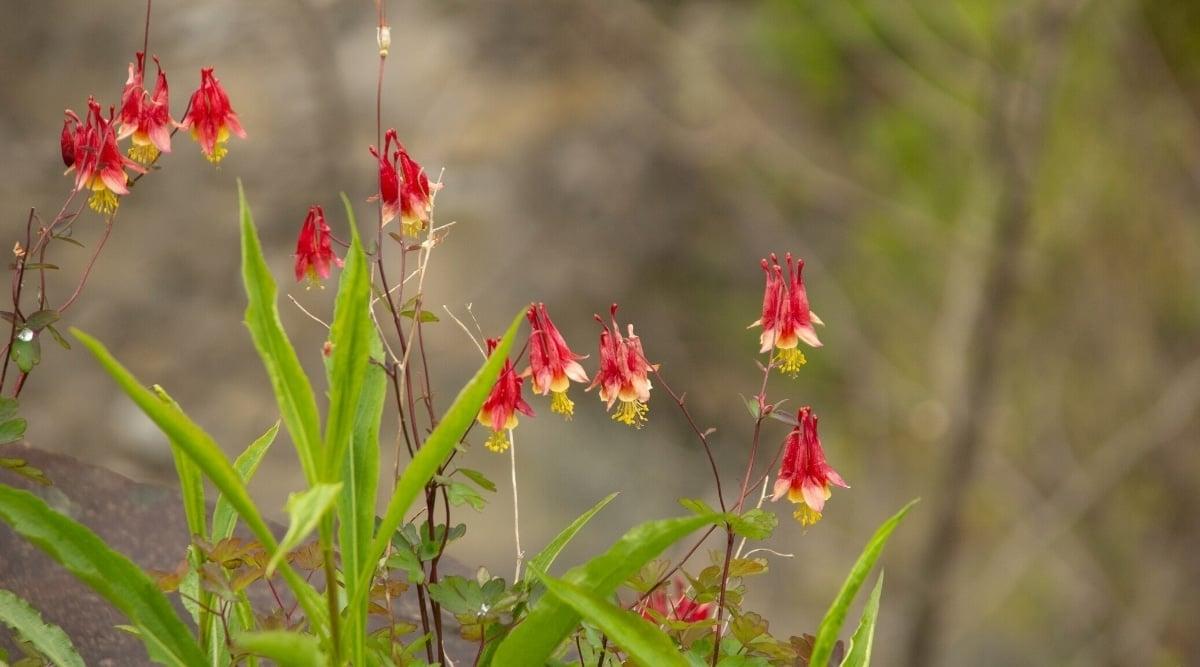
The elegant bell-shaped flowers of the columbine plant add a touch of red to any outdoor area. Scientifically known as Aquilegia, these flowers get their name from the Latin word “aquila,” which translates to “eagle,” reflecting the resemblance of their petals to an eagle’s talons. Columbines are renowned for their beauty, featuring drooping bell flowers in various shades of red and soft yellow. Their unique tubular shape and nectar-filled spurs make them particularly appealing to pollinators like hummingbirds and butterflies with long tongues. Despite their short lifespan, columbines are prolific self-seeders once they take root, flourishing in bushy clumps that can reach heights of 18 to 38 inches and spreads of 8 to 18 inches. These flowers thrive in full sun or partial shade, thriving in nutrient-rich soil with consistent moisture – drought is not their friend. Perfect for cottage gardens or rain gardens in USDA zones 3 to 9, columbines are a delightful addition to any outdoor space.
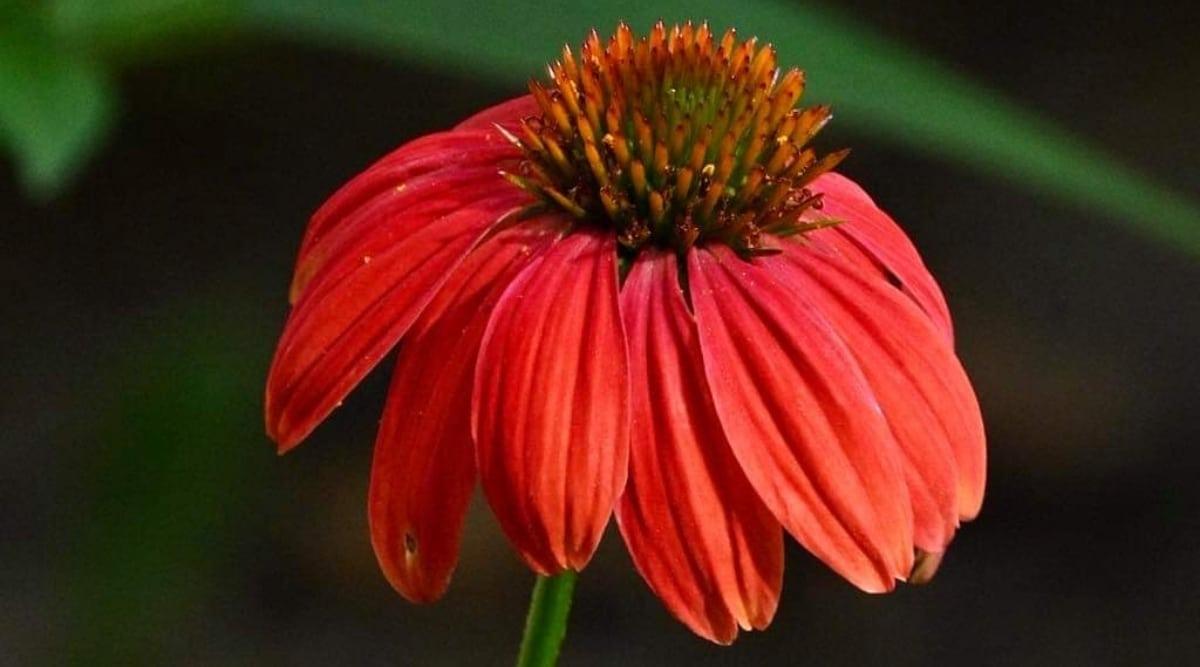
The coneflower, also known by its scientific name Echinacea, is a stunning flower that attracts pollinators with its vibrant colors and unique shape. The red coneflower, or Firebird, resembles a shuttlecock flying through the air, with large, feathery petals in fiery orange-red hues and a striking center of densely compacted stigmas in a dark red corkhead shape. These eye-catching flowers bloom vigorously throughout the summer, making them perfect for wildflower gardens and as cut or dried flowers. Growing in clumps reaching 2 to 3 feet in height, coneflowers are low-maintenance plants that thrive in well-drained soil with either dry or moderately moist conditions, under full sun or partial shade. It’s important to keep the soil somewhat infertile to prevent them from becoming leggy. With their hardiness, coneflowers can flourish in USDA zones 4-10.
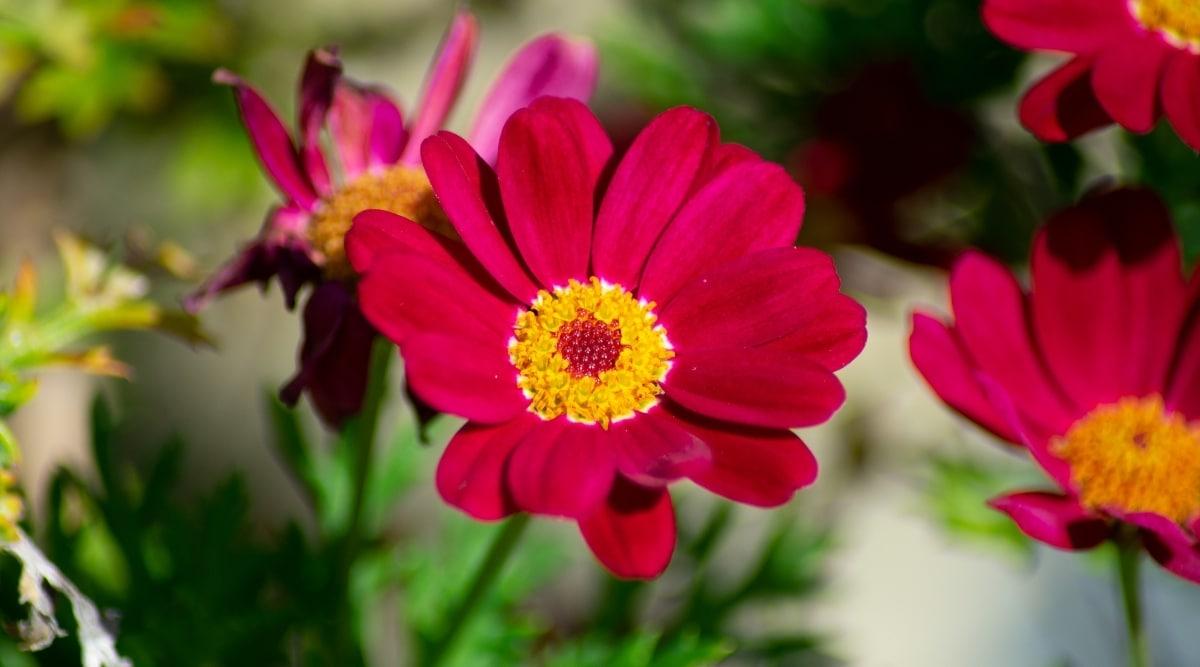
These vibrant flowers are not only visually appealing but also low-maintenance. Known scientifically as Cosmos, these plants originate from Mexico and are also known as Rubenza due to their striking ruby-red flowers that resemble precious gemstones. Blooming from summer through fall, Cosmos adds a sunny and fresh touch to any garden, whether planted in containers, flower beds, or as borders in a cottage garden. Cosmos are beloved by both humans and pollinators for their charm. While they are generally resilient to pests, it’s important to keep an eye out for slugs and aphids. For optimal growth, plant Cosmos in full sun with well-drained soil that receives regular moisture. By removing spent blooms, you can encourage continuous blooming and extend the plant’s lifespan. In USDA zones 2 to 11, Cosmos can spread through self-seeding and typically grow to be around 20 inches tall and 30 inches wide. Enjoy the beauty of Cosmos with minimal effort required in maintaining these lovely flowers.
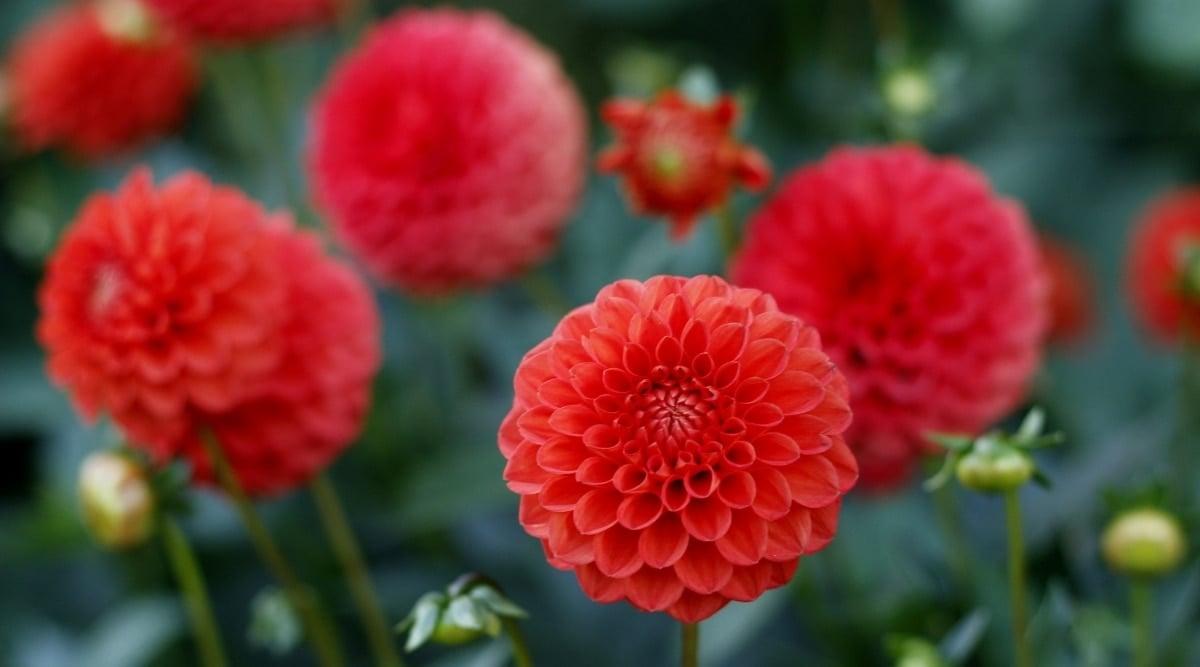
The stunning dahlia is a beautiful flower that can thrive both in a garden or as a lovely addition to a vase in your home. Dahlias, scientifically named as such, are exquisite blooms that come in a variety of colors, with shades of red being particularly striking. These flowers have multiple layers of luxurious petals, making them a great addition to any garden. Known for blooming late in the season, dahlias provide vibrant colors and visual interest from midsummer all the way up to the first frost of the year. They are popular choices for floral arrangements and can brighten up any space during the colder months. Fortunately, dahlias are relatively easy to care for, making them suitable for gardeners of all levels. Despite the rewarding blooms, dahlias simply require full sun exposure, at least 6 to 8 hours daily, to produce the most flowers of the highest quality. These flowers thrive in rich, loamy soil with good drainage, benefiting from compost and fertilizer applications to enhance blooming. Once established, water your dahlias once or twice weekly to keep them healthy and growing. Depending on the variety, dahlias can reach heights anywhere from 1 to 6 feet. While they need protection in USDA zone 7, they will flourish in zones 8 through 10.
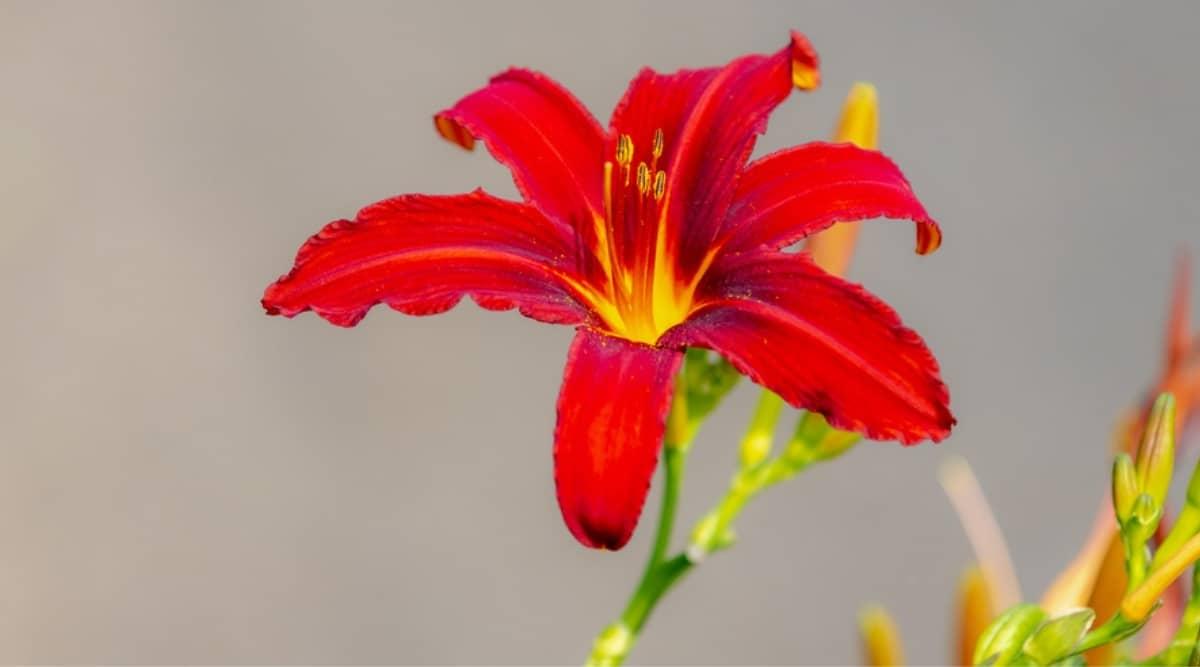
These vibrant red daylilies only grace your garden for a fleeting day or two, hence their fitting name. Also known as Hemerocallis, these stunning plants are perennials that require minimal effort to grow. Their array of vivid colors, including red, brings a burst of beauty to any garden. Perfect for those new to gardening, daylilies are low-maintenance and provide a continuous display of blossoms through self-seeding. Blooming from spring to late summer, they require ample sunlight, thriving best in full sun for at least 6 to 8 hours daily. In hot climates, partial shade can protect them from scorching. Daylilies adapt well to various soil types, but they prefer rich, fertile, slightly acidic loamy soil. During the growing season, water them regularly, then reduce watering once they are established. These resilient beauties flourish in USDA zones 3 through 10.
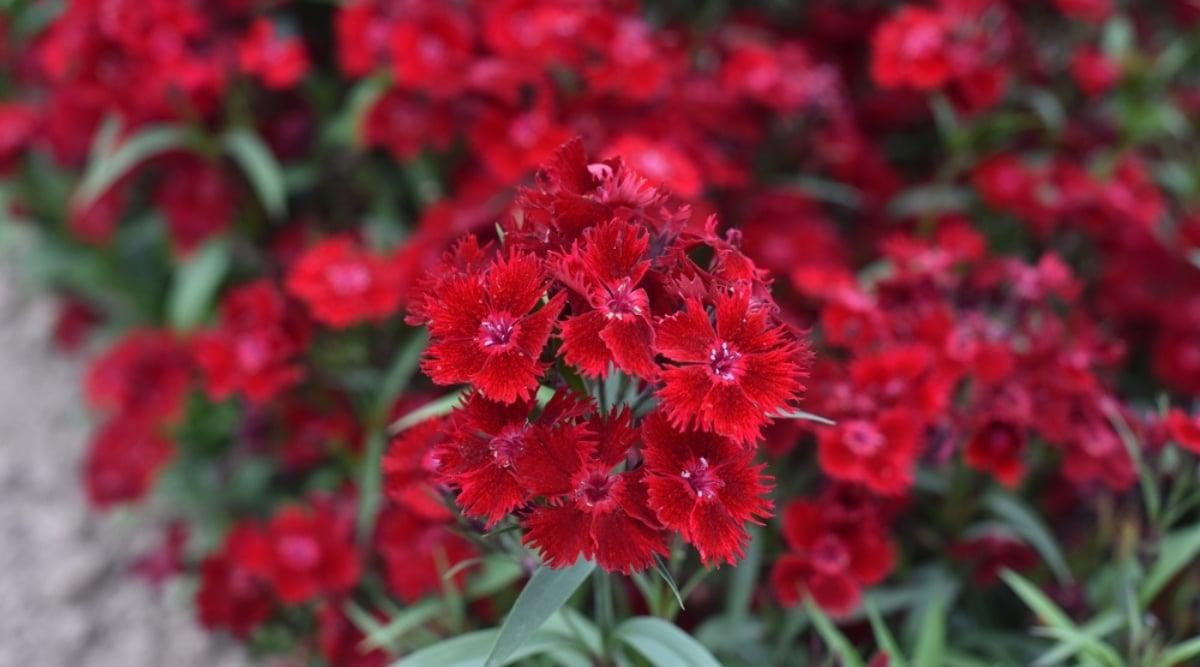
The dianthus plant is known for its vibrant blooms, with a range of colors to choose from, including the striking red variety. With its sweet and charming appearance, dianthus adds a lovely touch to less formal flower beds. For an eye-catching display, consider planting different colored dianthus varieties together. This easy-to-grow flower thrives in various conditions, even those that may seem challenging. Whether you’re a beginner or a seasoned gardener, dianthus is a great choice with its delicate blooms. Ranging in height from 6 to 36 inches and spreading around 6 to 24 inches wide, dianthus is versatile in any garden. To ensure the best growth and blooming, plant your dianthus in a sunny spot that receives at least 6 hours of sunlight daily. Well-drained soil is a must to prevent issues like rot. Aim for neutral to slightly alkaline soil pH for your dianthus plants. Water them weekly and avoid excessive fertilizer. Dianthus thrives in USDA zones 3 through 9, making it a suitable choice for a wide range of climates.
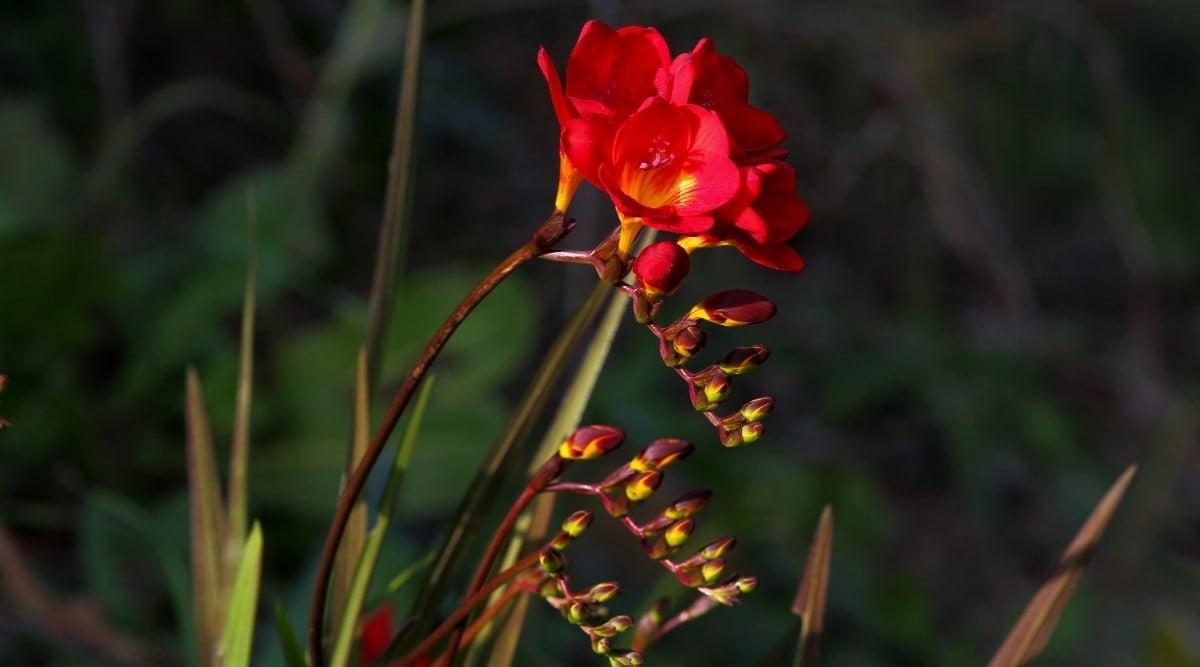
These beautiful red flowers, known as Freesias, are not only admired for their delicate colors and sweet fragrance but also for their stunning shades of red. Some believe that red Freesias have the most powerful scent, adding an extra sensory element to your garden. To prevent them from tipping over, it may be necessary to provide support for these compact plants that grow up to 2 feet tall. Freesias thrive in full sun but can also tolerate some morning shade. It is essential to plant them in well-draining soil that has been enriched with compost for added nutrients. While they require regular watering to keep the soil moist, overwatering should be avoided. Once established, Freesias only need to be watered approximately once a week. These lovely flowers prefer USDA zones 9 through 10 for optimal growth.
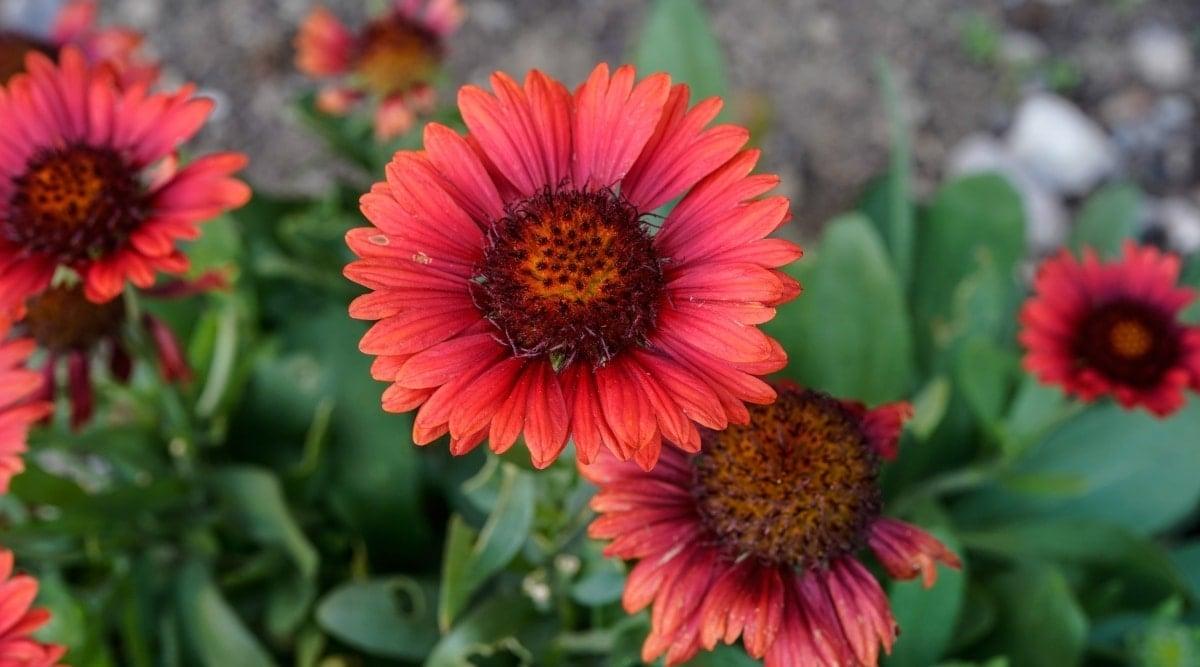
If you’re on the hunt for a fantastic starter flower for your garden, consider adding gaillardia to your collection. Also known as the blanket flower, gaillardias are easy-to-grow, short-lived perennials that will bring brightness and cheer to your garden. Whether you’re a novice or experienced gardener, these flowers are a great choice as they grow quickly and will bloom in their first year. Their vibrant colors, including shades of red, are a true joy to behold. Gaillardias typically reach heights of 12 to 18 inches and spread 12 to 24 inches wide. For optimal blooming, make sure your gaillardias receive full sun. However, if you live in a hotter climate, partial shade can work too. These flowers thrive when they have plenty of sunlight to soak up. Regarding soil, gaillardias are not picky, but they prefer soil that is not too clay-rich, as this can harm the plant. Ensure the soil is well-draining to prevent any root rot issues. Once established, gaillardias are quite resilient to drought conditions. These flowers flourish in USDA zones 3 through 10.
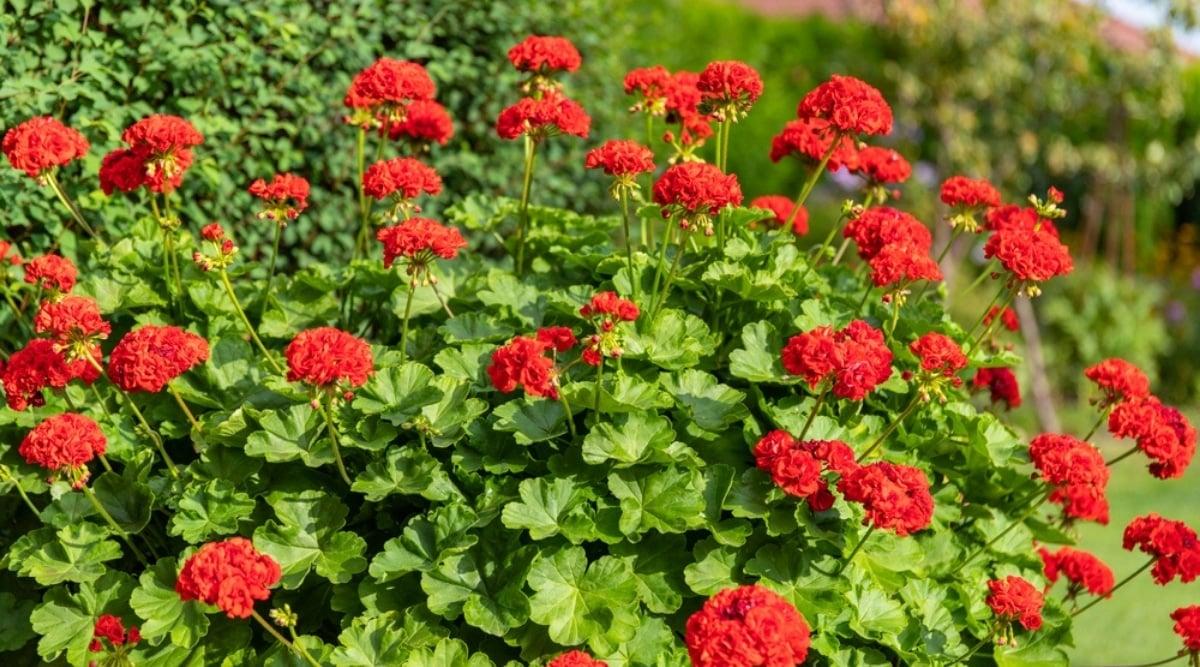
Geraniums, scientifically known as Pelargoniums, are popular for their vibrant red flowers that bloom almost all year round. These versatile plants come in various shapes, sizes, and colors, making them a great addition to any garden. Despite their low-growing nature, geraniums create a captivating display and are perfect for filling in empty spaces or as ground cover. Whether your garden needs extra color or ground cover, there is a geranium variety to suit your needs. They thrive in full sun or partial shade, with more sunlight hours leading to more abundant blooms. However, be sure to water them adequately if they receive plenty of sun to avoid damage. Geraniums are not fussy about soil type but prefer neutral to alkaline pH levels and well-drained soil. Water them only when the soil is very dry, and they should thrive. Depending on the variety, geraniums grow best in USDA zones 3 through 9. Do some research to find the perfect geranium for your garden and enjoy their beauty year-round.
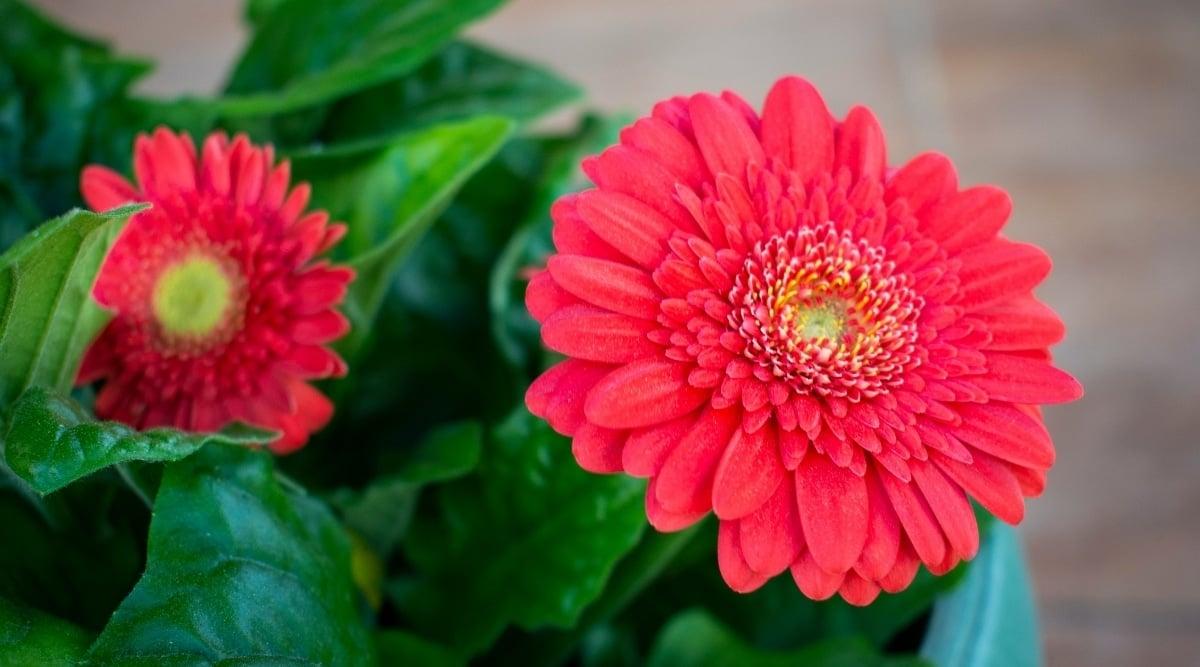
The gerbera daisy is a stunning choice for your garden or a vase, with its vibrant and cheerful blooms. With its numerous petals surrounding a green or black center, it bears a resemblance to sunflowers and has a similarly lively and vibrant effect. Available in a variety of colors, including striking red hues, gerbera daisies are a colorful addition to any space. To help your gerbera daisies thrive, ensure they receive plenty of sunlight while also protecting them from excessive heat, especially in hot climates. Providing some shade during the hottest part of the day can help them flourish. These flowers prefer nutrient-rich soil with good drainage, so consider adding compost or fertilizer to promote blooming. Monitoring the pH level of the soil is essential, aiming for a range of 5.5 to 6.5 to prevent chlorosis. Water your gerbera daisies with at least one inch per week to maintain healthy growth and abundant flowers throughout the summer and fall. These plants do best in USDA zones 8 through 10.
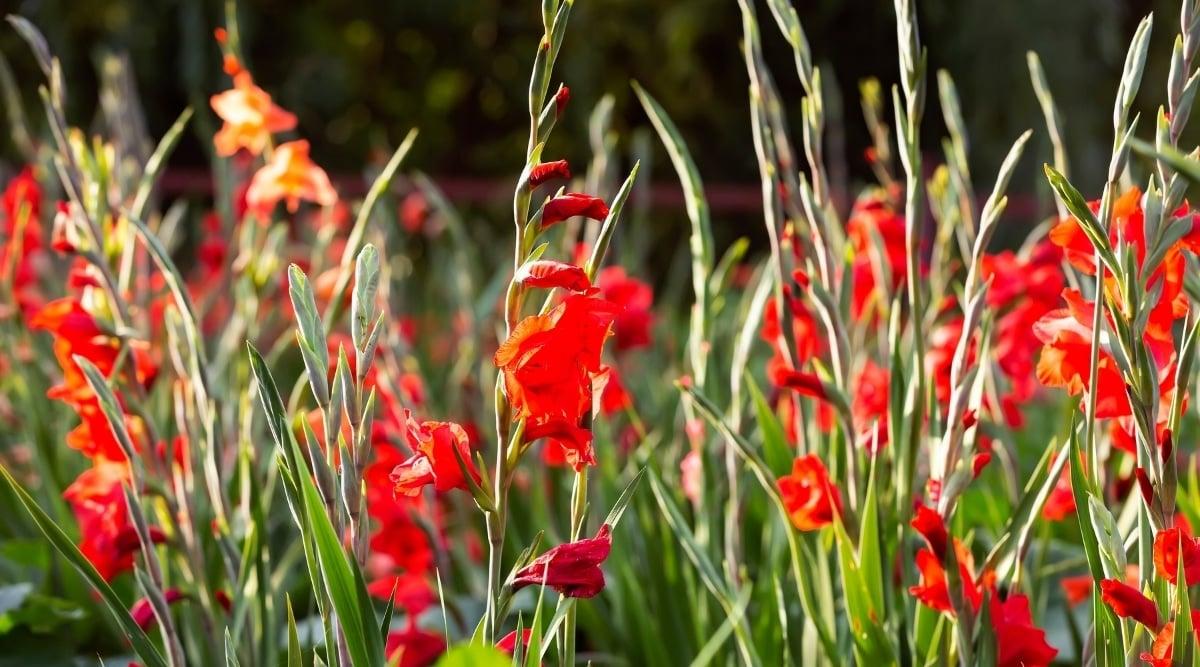
The elegant red blooms of the Gladiolus plant stand tall on their stalks, adding a touch of beauty to any garden. Gladiolus, known scientifically as Gladiolus, comes in a variety of stunning colors, with red being a popular choice. These flowers, with their beautiful ruffled petals, can grow quite tall, reaching heights of 2 to 5 feet. To help them stand tall and make a statement, it’s a good idea to stake them for support. One of the great things about Gladiolus is that they attract pollinators, making them a wonderful addition to any garden that needs a boost in pollination or if you simply enjoy seeing butterflies fluttering around. These sun-loving flowers thrive in full sunlight, although they can still bloom in partial shade, just not as frequently or abundantly. Gladiolus plants are not too picky about soil types, as long as the soil has good drainage. Water them about once a week, and you’ll find that they are fairly easy to care for, making them a perfect choice for novice gardeners. These plants do best in USDA zones 7 through 10.
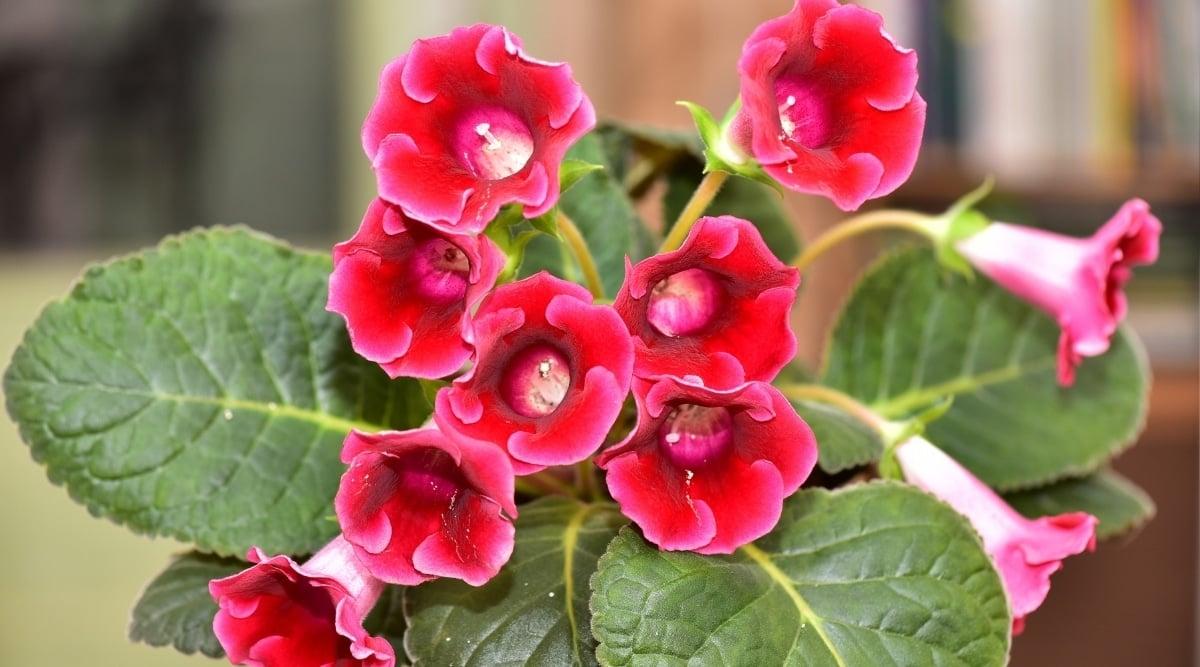
These flowers can be planted outdoors, but they thrive in controlled indoor conditions. Known scientifically as Sinningia speciosa, Gloxinia plants are delightful and charming, producing small flowers quickly. They are fast-growing and can be quite satisfying to cultivate and care for. They are also easy to grow, making them a great choice for beginners in gardening. Gloxinia flowers come in various colors, including shades of red. Keep in mind that after their initial blooming period, they may not bloom as prolifically, so you may need to replace them periodically. Despite their vibrant colors, Gloxinia plants do not do well in direct sunlight and prefer plenty of indirect light to promote growth. It is essential to keep the soil consistently moist during the growing season, using slightly acidic, loose, and well-draining soil. When watering Gloxinia, be careful to water only the soil to prevent browning of the leaves. Fertilize according to your preference to encourage more blooms. Gloxinia plants thrive best in USDA zones 11 to 12.
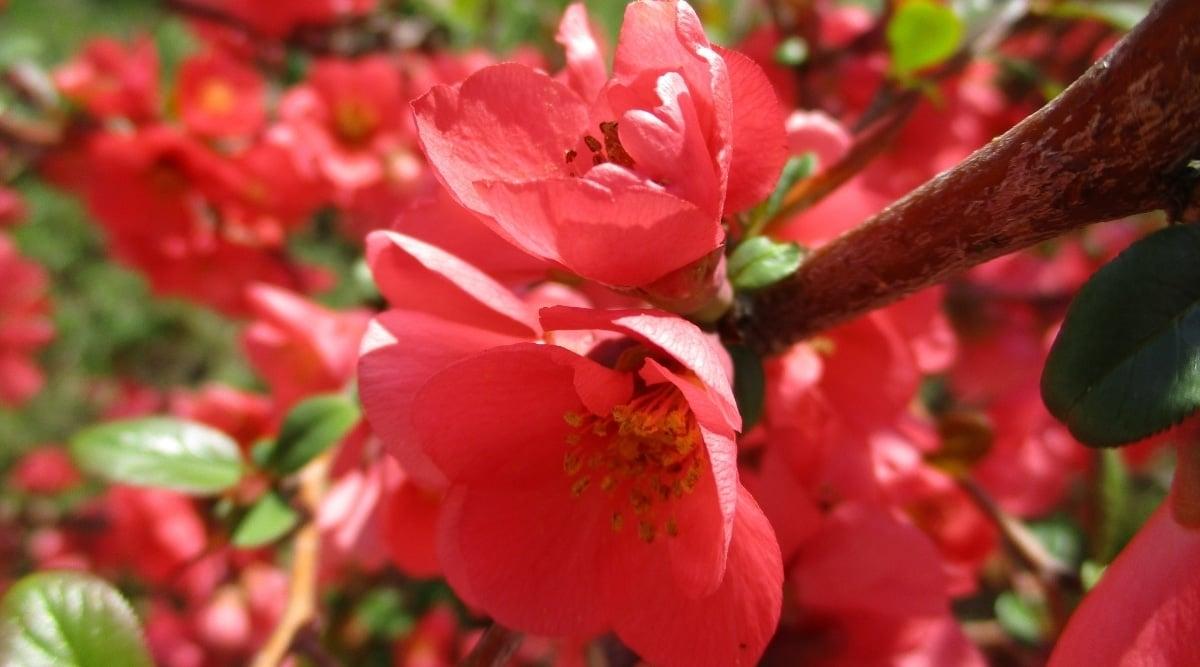
Growing and maintaining Hellebore flowers can be a challenging task, but the effort is worth it when you see their stunning bright blooms. With the scientific name Helleborus, these plants have a fascinating history of being notoriously difficult to grow, reserved for only the most experienced gardeners. However, thanks to advancements in science, there are now varieties available that are easier to grow and incredibly rewarding. Hellebores come in various colors, including red, and their evergreen foliage adds beauty to your garden all year round. Blooming in the spring, these plants typically reach heights of 1 to 2 feet and spread out in a similar fashion. It’s essential to provide your Hellebores with partial to full shade as they prefer not to be in direct sunlight. They thrive in rich, well-drained soil, so consider adding compost and fertilizer to the mix. Maintaining a neutral to alkaline pH in the soil is ideal for these plants. When it comes to watering, be careful not to overdo it to prevent rotting. Keep the soil moist while they are growing, as Hellebores are somewhat resistant to drought once they have established themselves. These plants typically do best in USDA zones 3 through 9, but this may vary depending on the species and variety you choose for your garden.
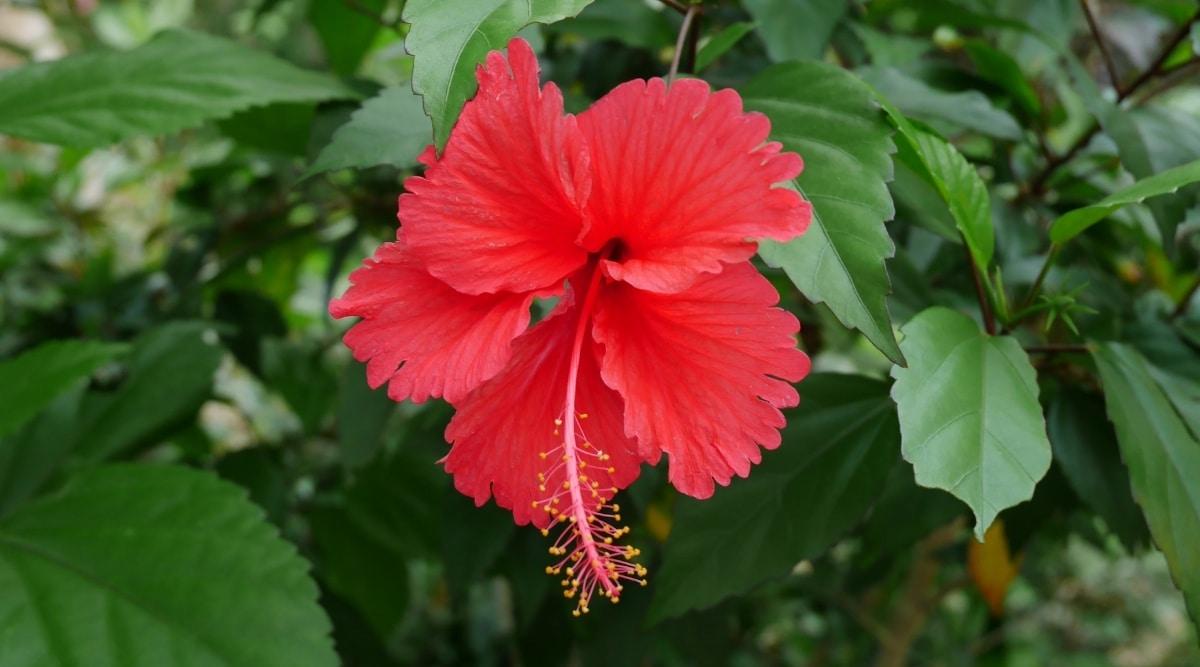
The tropical hibiscus is a vibrant and iconic flower that brings to mind the tropical breezes of exotic locales. With its dazzling array of colors, including stunning shades of red, the hibiscus is a perfect choice for adding drama and color to any garden. This fast-growing shrub, when fully mature, can reach heights of 4 to 10 feet and a spread of 5 to 8 feet. While hibiscus plants thrive in warmer climates, they can also be grown in more temperate regions for part of the year. To keep your hibiscus happy, ensure they receive plenty of sunlight in colder climates and partial shade in hotter areas. The key to a healthy hibiscus is ensuring it is constantly blooming. Plant them in soil rich in organic matter, such as compost, with good drainage to prevent root rot. Be sure to water your hibiscus regularly, with more frequent watering in dry and hot conditions. Hibiscus plants thrive best in USDA zones 9 through 11.
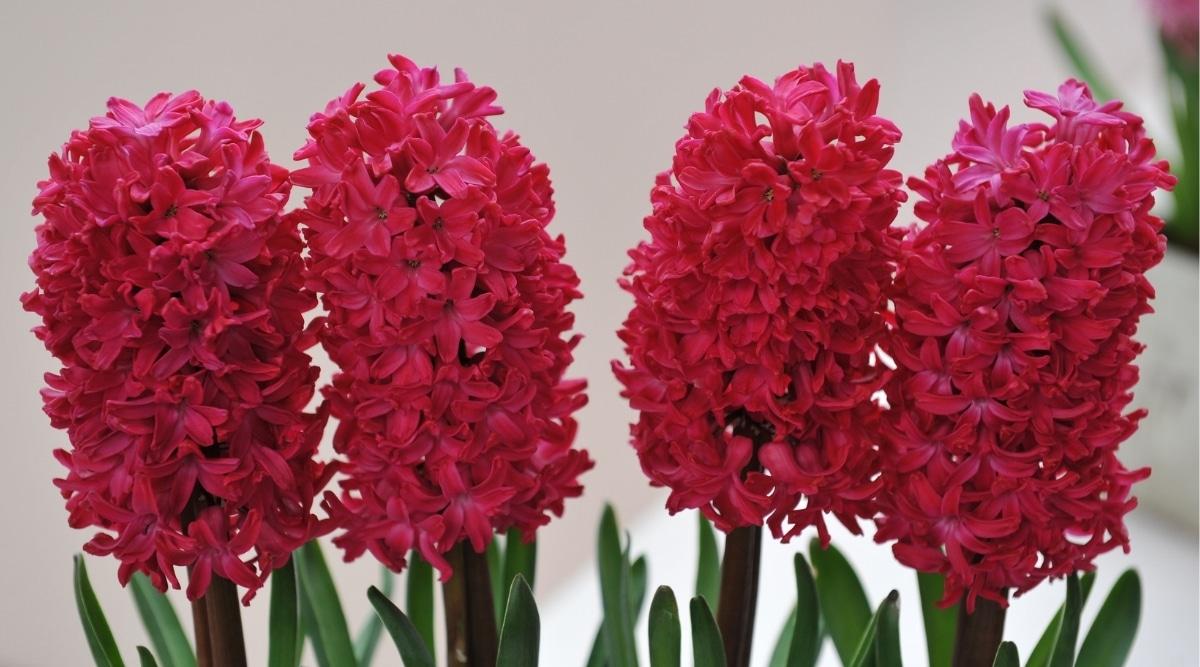
Hyacinths are commonly found in purple or blue hues, but they also boast a striking red variety. With the scientific name Hyacinthus, these popular flowers feature densely-packed florets in a range of colors. The most typical shade is purple, but they can also bloom in a deep pink or crimson red. Known for their delightful fragrance, hyacinths easily establish themselves in the right conditions. While the number of florets may decrease over time, hyacinths thrive in well-drained, moderately moist soil. They can be planted in full sun or partial shade to retain soil moisture. Plant hyacinth bulbs about 6 inches deep, where they will grow to a height of 6 to 10 inches and spread out over 4 to 6 inches. Keep them spaced 5 to 6 inches apart from other flowers. These winter-hardy plants flourish in USDA zones 4 to 8, but in warmer climates, it’s advised to pre-chill the bulbs before planting for optimal growth.
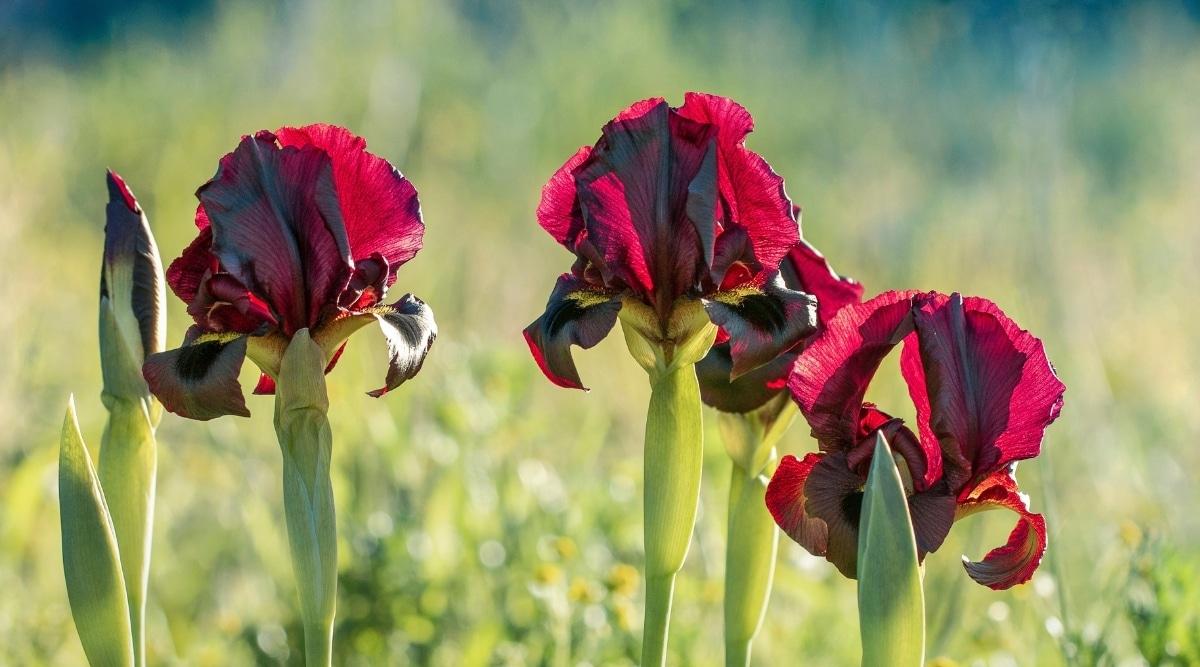
The vibrant red hue of the red iris remains strong even in various conditions. Known scientifically as Iris, these red irises are known for their colorfast nature, maintaining their bright burgundy red color even when exposed to direct sunlight. Their deep red petals are accented by striking indigo veins and yellow accents at the base. They can be planted in both partial shade and full sun without losing their vivid color. To plant red irises, their rhizome should be placed about half an inch to one inch deep in moderately moist soil or bare root at the soil line. They typically grow to be around 34 to 37 inches tall and wide, producing 4 to 5 flowering stems per bulb. These red irises are resilient to drought and thrive in USDA zones 3 to 10, with a higher chance of reblooming in zones 5 to 10.
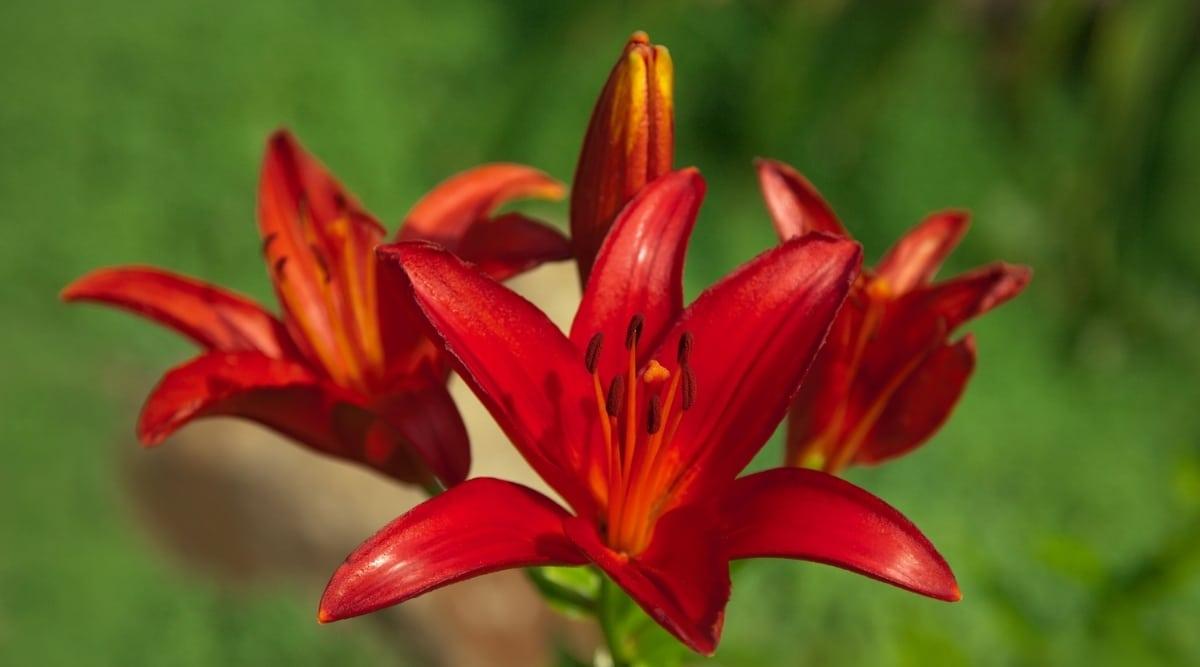
Similar to many vibrant flowers, lilies thrive when they receive full sunlight throughout the day. With the scientific name Lilium, these beautiful blooms are a popular choice with their striking red petals. Lilies are a fantastic addition to any garden, providing a burst of color and adding visual appeal. Not only do they look beautiful, but they also emit a delightful fragrance that attracts pollinators. Growing anywhere from 30 to 36 inches tall and spreading 8 to 12 inches wide, lilies bloom from mid to late summer, offering a treat for the eyes. While lilies may not bloom as long as some other plants, they are relatively easy to care for, depending on the specific variety you choose. They make a great option for cut flowers and look stunning in any floral arrangement. To ensure your lilies thrive, give them plenty of sunlight for optimal blooms. In hot climates, providing some shade in the afternoons can be beneficial. Make sure to plant them in well-drained soil and water deeply when the soil is dry to the touch. Lilies prefer USDA zones 3 through 9 for ideal growing conditions.
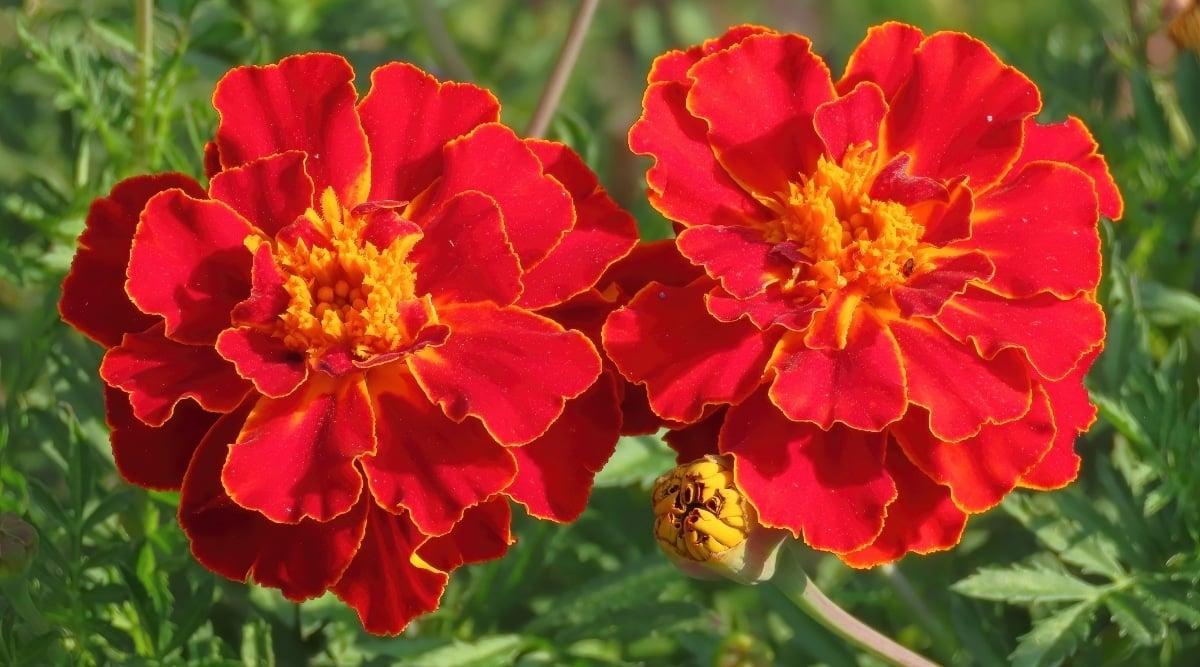
Marigolds are typically seen in shades of yellow or orange, but they can also bloom in a striking red color. These vibrant and delightful flowers, scientifically known as Tagetes, are a wonderful addition to any garden. They are known for their adaptability and low maintenance requirements, making them a popular choice for many gardeners. Marigolds are annual plants, so they need to be replanted each year. However, the effort is well worth it when you see the beautiful blooms they produce. These flowers thrive in full sun and are able to withstand high temperatures. They are not picky about soil, as long as they are watered occasionally during dry periods. To achieve the best results, it is recommended to ensure that the soil is not too acidic. Weekly watering is sufficient for well-established plants to thrive. Marigolds are easy to care for and will bloom in a vibrant red color in all USDA hardiness zones.
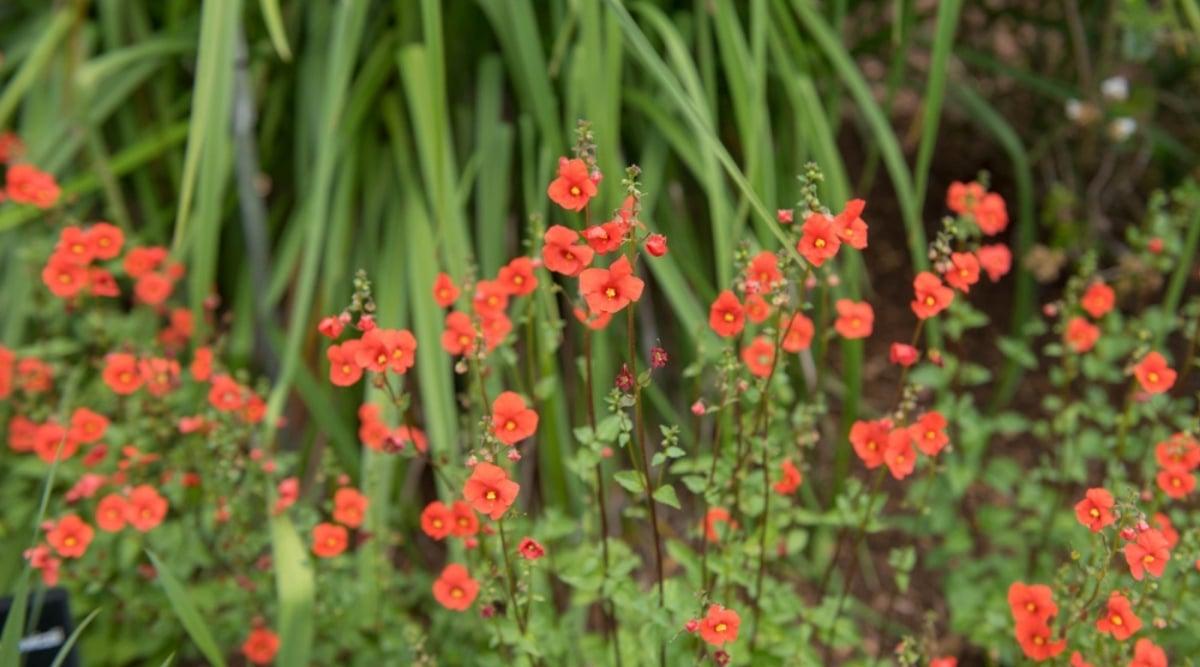
These charming little blooms bring a burst of vibrant red to your garden during the warmer months. Known scientifically as Alonsoa, mask flowers are delightful annuals that can sometimes act as perennials in regions without frost. Blooming from early summer to early fall, they offer a continuous display of deep, red hues all season long. While their flowers may be small, they make a big impact, so feel free to plant plenty of them! At full maturity, they reach a height of 24 to 30 inches and may benefit from staking for optimal growth. Loved by pollinators, mask flowers thrive in full sun but can also tolerate partial shade. They prefer light, fertile, well-drained soil with a neutral to slightly alkaline pH for the best results. Mask flowers flourish in temperate climates where they are protected from extreme heat or frost. They are hardy in USDA zones 9 through 11, making them a versatile and beloved addition to any garden.
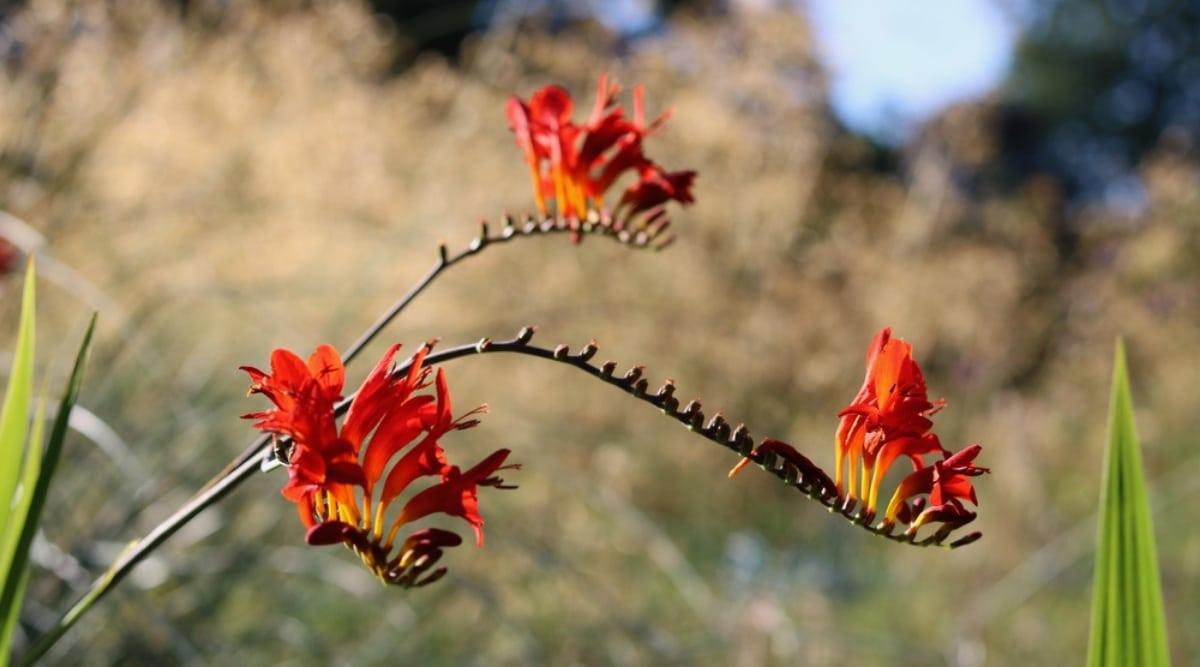
These beautiful and unique flowers are a magnet for butterflies and hummingbirds. Known scientifically as Crocosmia × crocosmiiflora, Montbretia is a striking addition to any garden with its vibrant, crimson blooms that last from mid-summer to mid-fall. These flowers are a favorite among pollinators, making them a wonderful choice for those looking to attract more wildlife to their garden. Montbretia plants can reach heights anywhere from 1 to 5 feet, and their branches can be snipped off to create lovely flower arrangements for your home. Thriving in full sun but also tolerant of partial shade, these plants love the heat and humidity of summer and can even withstand drought once established. They prefer moderately rich soil with good drainage and consistent moisture. Montbretia is relatively low-maintenance, making it a great option for novice gardeners looking to add something special to their landscape. Ideal for USDA zones 5 through 10, Montbretia is a versatile and stunning choice for any garden.

The petite red pentas flower brings a lively touch to any garden setting. Known scientifically as Pentas lanceolata, these perennial plants are famous for their stunning star-shaped flowers that captivate year after year. While they come in a variety of colors, the rich, vibrant red hue they produce is particularly striking. If you’re considering adding pentas to your garden, you’ll be pleased to learn that they are relatively easy to care for. They are ideal for both novice and seasoned gardeners. Growing up to 6 feet tall with a 3-foot spread, pentas are a slow-growing shrub that will eventually reward you with its beautiful blooms. Ensure your pentas receive plenty of sunlight to thrive and bloom best. They prefer well-drained soil that is watered regularly. However, once established, they are drought-tolerant, as they enjoy basking in the heat. Pentas thrive in USDA hardiness zones 9 through 11.
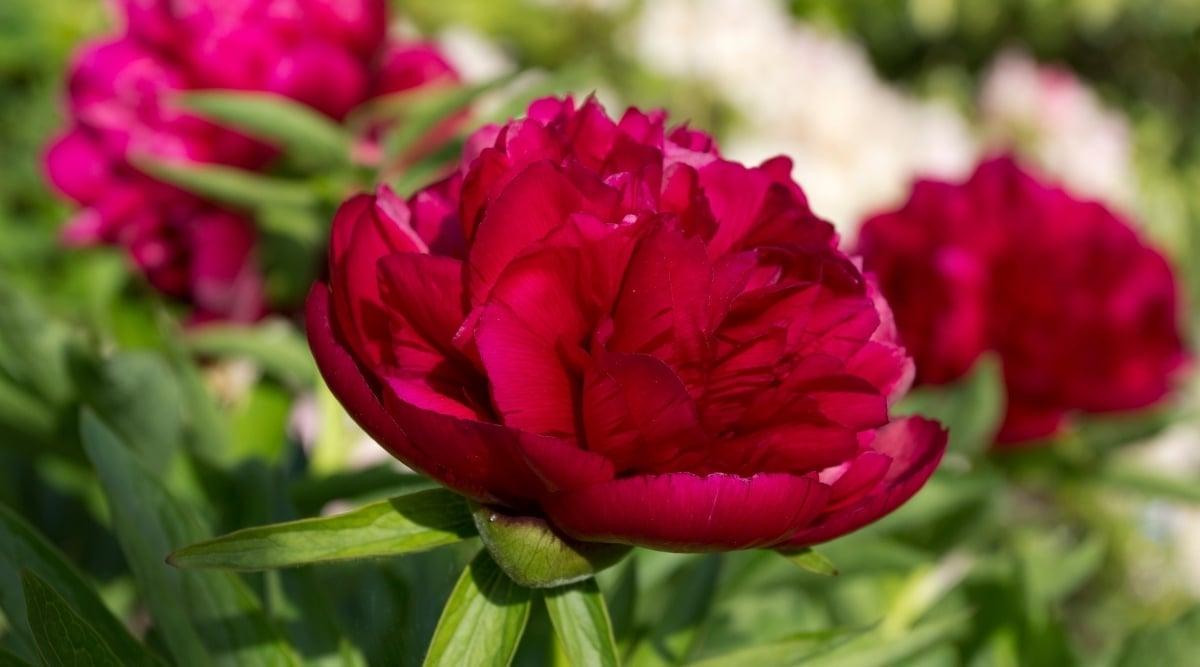
Peonies, scientifically known as Paeonia, are a beloved flower choice for bouquets due to their full and vibrant appearance. These beautifully ruffled flowers come in various colors, from delicate pinks to striking scarlet red, adding a dramatic touch to any garden. Blooming in mid to late spring, it’s important to enjoy their beauty while they last. To ensure a bountiful display of blooms, plant peonies during their dormant period in the autumn. These flowers thrive best in full sun but can tolerate light shade, especially in warmer climates. They prefer neutral to acidic soil, so it’s best to avoid more acidic soil. Good drainage is essential to prevent rot, and fertilizing or using compost can help provide the necessary nutrients for optimal growth. Peonies typically flourish in USDA zones 3 through 8, making them a popular choice for gardens across the country.

Petunias are a breeze to cultivate and thrive whether dangling from baskets or adorning flower beds. Scientifically known as Petunia, these charming flowers can be cultivated as either an annual or perennial, contingent upon your living zone. With their rapid growth rate and low maintenance needs, they make a delightful addition to any garden. Their vibrant red blossoms are perfect for injecting a splash of color into your outdoor space. Whether planted in beds or pots, petunias are sure to attract the delightful presence of hummingbirds, plus they can withstand scorching heat and dry spells. Reaching heights of 6 to 12 inches and spreading 30 to 40 inches wide, they make an excellent choice for ground cover. Petunias thrive under bright sunshine, but can also tolerate a bit of shade. They prefer soil that is moderately fertile, rich in humus, and moist; ensuring good drainage is key to preventing root rot. Regular pruning and deadheading will help ensure your petunias remain in peak condition. Ideally suited for USDA hardiness zones 2 through 11, petunias are truly a versatile and lovely addition to any garden setting.
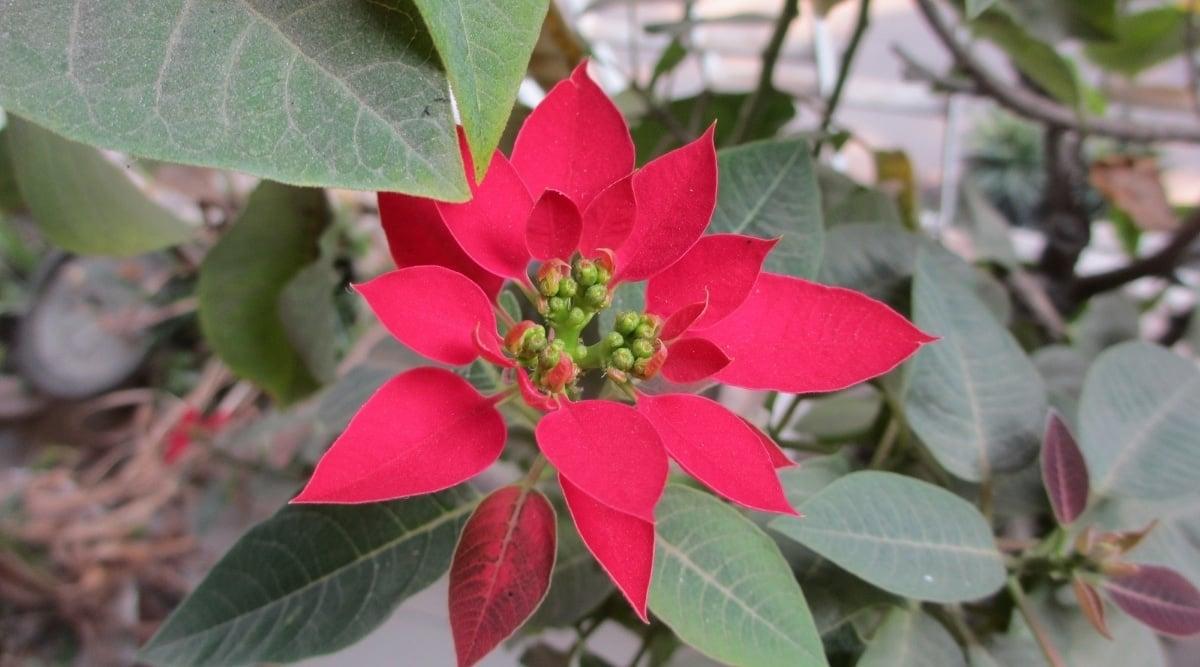
One of the most well-known holiday flowers is the poinsettia, with its vibrant red hue. Scientifically named Euphorbia pulcherrima, this plant is commonly associated with Christmas, marking the festive season’s arrival. It boasts stunning star-shaped red blooms that grace the plant from winter to spring. Growing up to 10 feet tall and spreading 7 feet wide, poinsettias also make excellent houseplants to bring holiday cheer indoors. Poinsettias thrive in full sun but can also do well in light shade. They prefer loamy, well-drained soils with a neutral-to-alkaline pH. While they are drought-tolerant, these plants require regular care to fend off pests and maintain their vibrancy. To preserve the deep red color of the flowers, place houseplants in a dark room after they’ve received at least half a day of sunlight, and keep them away from artificial light sources. Poinsettias flourish best in USDA hardiness zones 9 through 11.
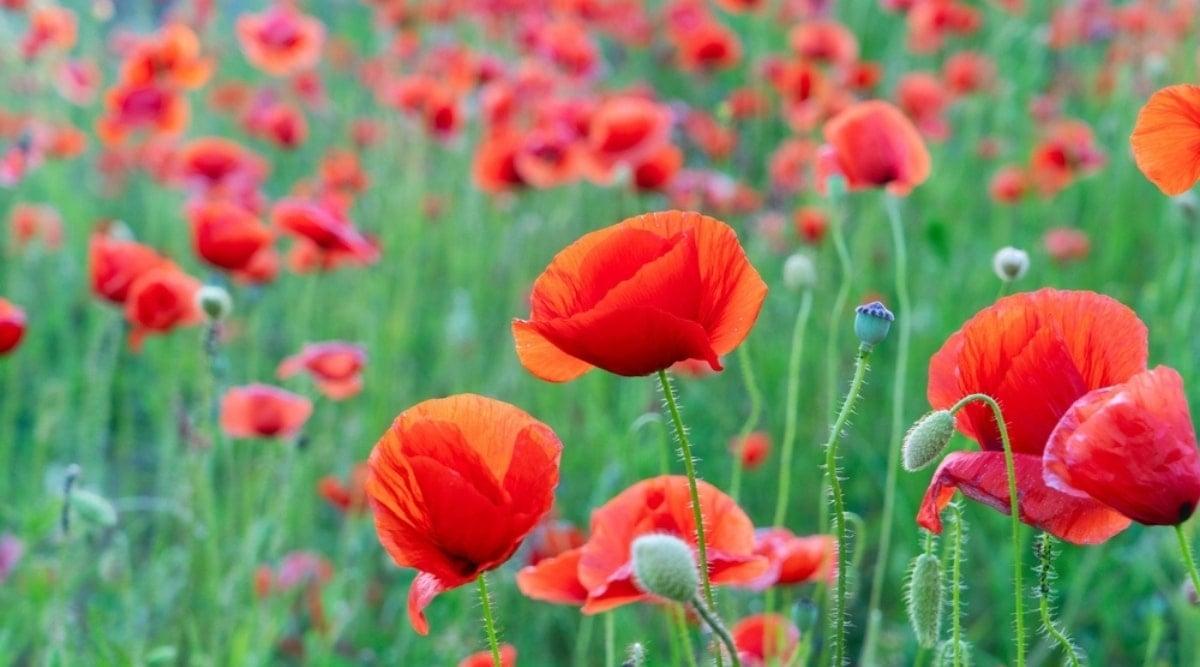
Red poppies, scientifically known as Papaver, are a popular choice for gardens and landscapes nationwide. These vibrant red flowers are a common sight in the stunning super blooms of the West Coast. Not only are red poppies visually striking, but they also hold significant symbolism as a tribute to those who have passed away. Growing between 6 to 12 inches tall and spreading 6 to 8 inches wide, these sun-loving flowers close up at night, during rainy weather, and on cloudy days. To ensure their happiness, give your poppies plenty of sunlight in sandy, well-drained soil with poor to average quality. These resilient flowers are heat and drought-resistant, making them a low-maintenance option for all types of gardeners. Red poppies thrive in USDA hardiness zones 8 through 10, making them a perfect addition to any garden in need of a pop of color.
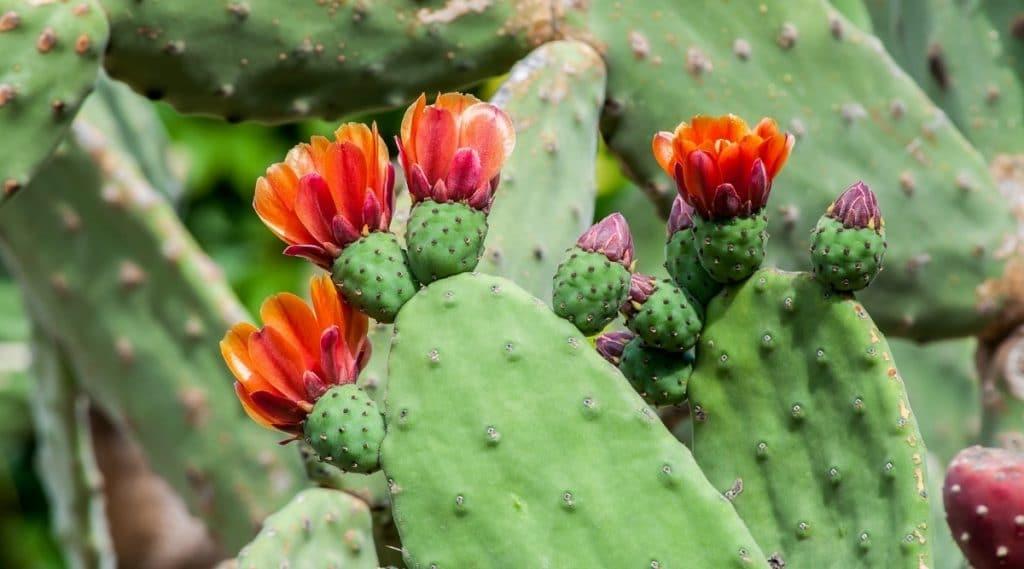
This particular type of cactus produces beautiful flowers that sprout from its fruit. Known scientifically as Opuntia, one distinctive red bloom in this category hails from the prickly pear, a type of cactus known for its vibrant and captivating flowers ranging from orange to red hues. Thriving in warm climates, these plants are incredibly resilient to dry conditions. Growing up to 15 feet in height with a 10-foot spread, they require ample space in your garden. For optimal growth, ensure these plants receive plenty of sunlight, typical of their natural habitat in arid regions. They can adapt to various soil types as long as good drainage is provided. Once established, prickly pears have low water requirements, thriving in minimal watering. While additional watering may be needed on scorching summer days, they can typically survive without it. These hassle-free plants make them suitable for any gardener seeking a low-maintenance yet visually appealing addition. Prickly pears are disease-resistant and flourish best in USDA zones 8 to 12, adding a touch of desert beauty to any garden.
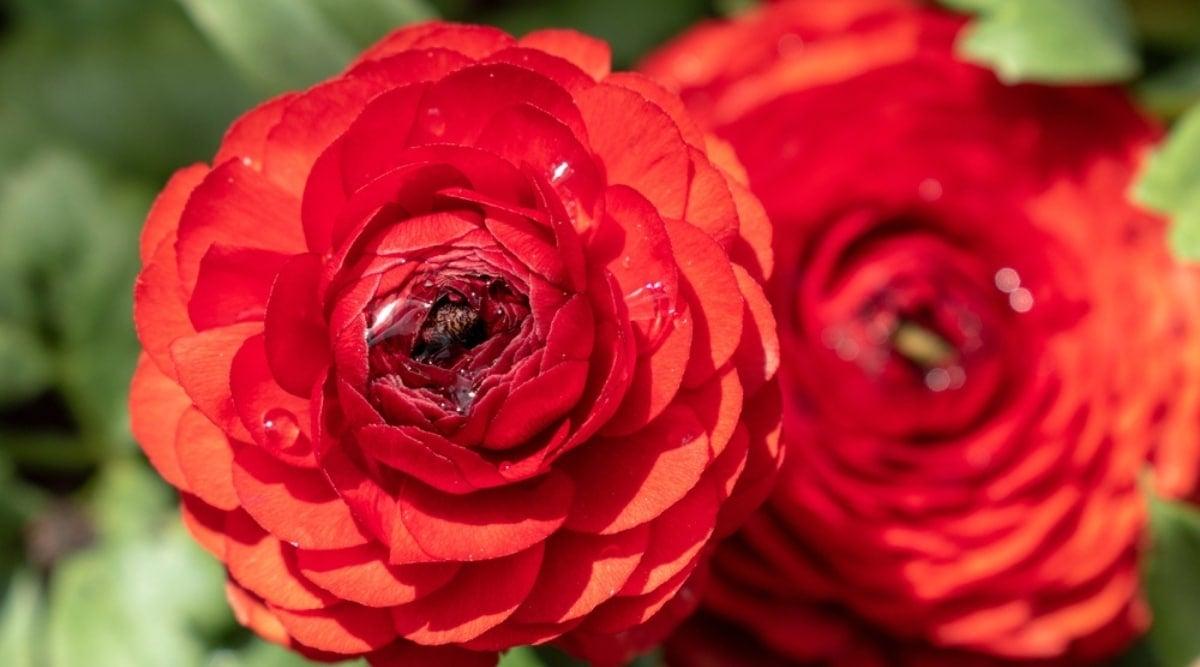
The ranunculus, also known as Persian buttercups, is a popular and vibrant flower that is commonly used for home decoration and in bouquets. With a wide range of colors, including red, these rose-like flowers can grow up to 1 to 2 feet tall and wide. Plant them in the fall or spring for beautiful blooms in the following spring and summer. To ensure your ranunculus flowers thrive, place them in full sun spots with at least 6 hours of sunlight. They prefer sandy or loamy soil with good drainage and a slightly acidic pH. When planting, water them generously and then wait until the first signs of growth before watering again to avoid rot. Ranunculus flowers thrive in cool spring weather and are best suited for USDA hardiness zones 8 through 10.
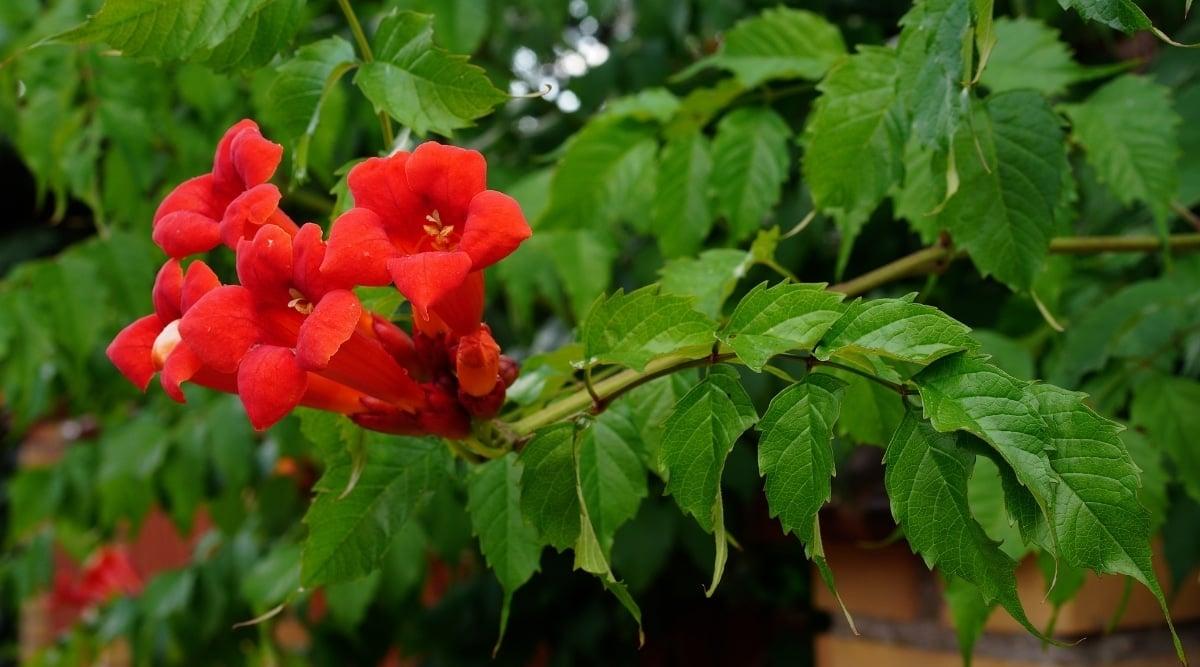
While the red trumpet creeper plant may be known for its invasive nature, with some TLC, it can really brighten up your garden. Known scientifically as Campsis radicans, these vines can be a stunning addition to any outdoor space if you’re willing to put in the effort to care for them properly. Regular pruning and attention can transform this vibrant red-orange blooming vine into a true showstopper in your garden, attracting hummingbirds and other pollinators. These beauties bloom from summer through fall, giving you plenty of time to enjoy their colorful flowers. Red trumpet creepers can thrive in both partial shade and full sun and are quite adaptable to different soil types, although they do prefer well-drained soil. Make sure to provide ample support for these vines, such as a sturdy trellis, as they can grow quite vigorously. It’s also a good idea to keep them away from your home, as their root system may cause damage to structures. These vines are hardy in USDA zones 4 through 9, so they should fare well in a variety of climates.
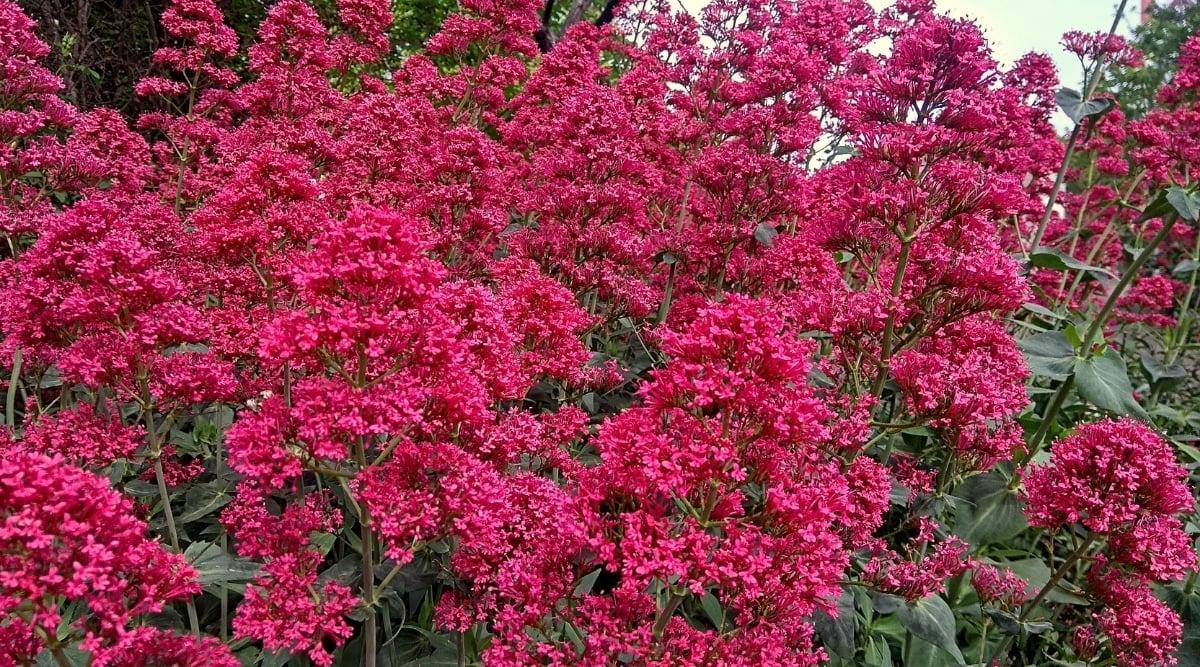
If you’re looking for a bush that adds a pop of color and a sweet fragrance to your garden, then the red valerian is the perfect choice for you. The scientific name for this lovely plant is Centranthus ruber. The red valerian is a stunning and bushy plant that blooms for long periods, gracing your garden with beautiful red flowers all year round. Not only do they look amazing, but they also emit a delightful scent that will enhance your outdoor space. These flowers are relatively easy to grow, making them a great addition to any garden. Additionally, they are a favorite among butterflies! From early summer to fall, the red valerian will fill your garden with lush foliage and striking ruby red flowers. Growing to a height of 2 to 3 feet and spreading 18 to 24 inches wide, they make a bold statement in any garden. While they can tolerate partial shade, red valerian thrives in full sun and produces the best blooms when placed in a sunny spot. These plants prefer soil with average richness and good drainage, and they even do well in sandy or poor soils. Red valerian is relatively resistant to pests and diseases, so you won’t have to worry too much about using pesticides. This plant thrives in USDA zones 5 through 8, making it suitable for a wide range of climates. Overall, the red valerian is a versatile and beautiful plant that will bring color, fragrance, and wildlife to your garden effortlessly.
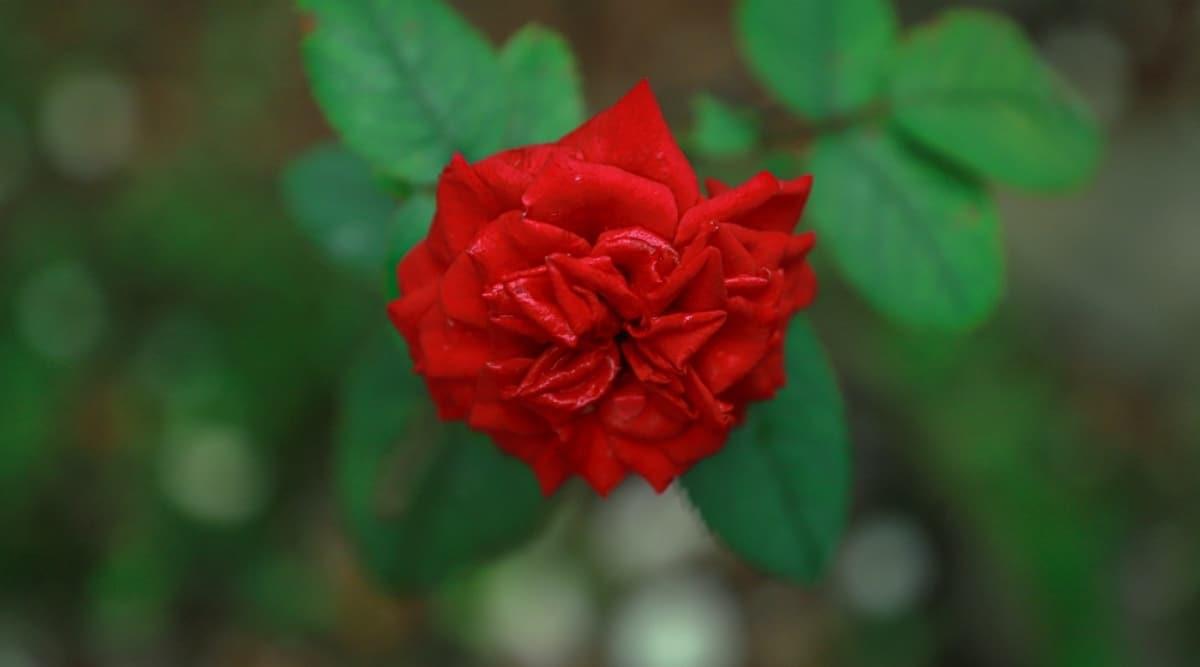
Red roses, scientifically known as Rosa, are undeniably one of the most beloved flowers in the world. These stunning blooms in shades of red are a classic choice for bouquets, but there are also many different varieties perfect for your garden. While growing roses may seem daunting, there are options suitable for all levels of gardening expertise. For optimal blooming, plant your roses in a spot that receives full sun for at least 6 hours a day. Make sure the soil is fertile and well-drained, adding compost to provide necessary nutrients. Water your roses weekly with at least an inch of water throughout the growing season to keep them healthy and thriving. Don’t forget to prune your rose plants to shape them as desired and promote more blooms. Most varieties of roses can thrive in USDA zones 3 through 10, making them a versatile and rewarding addition to any garden.
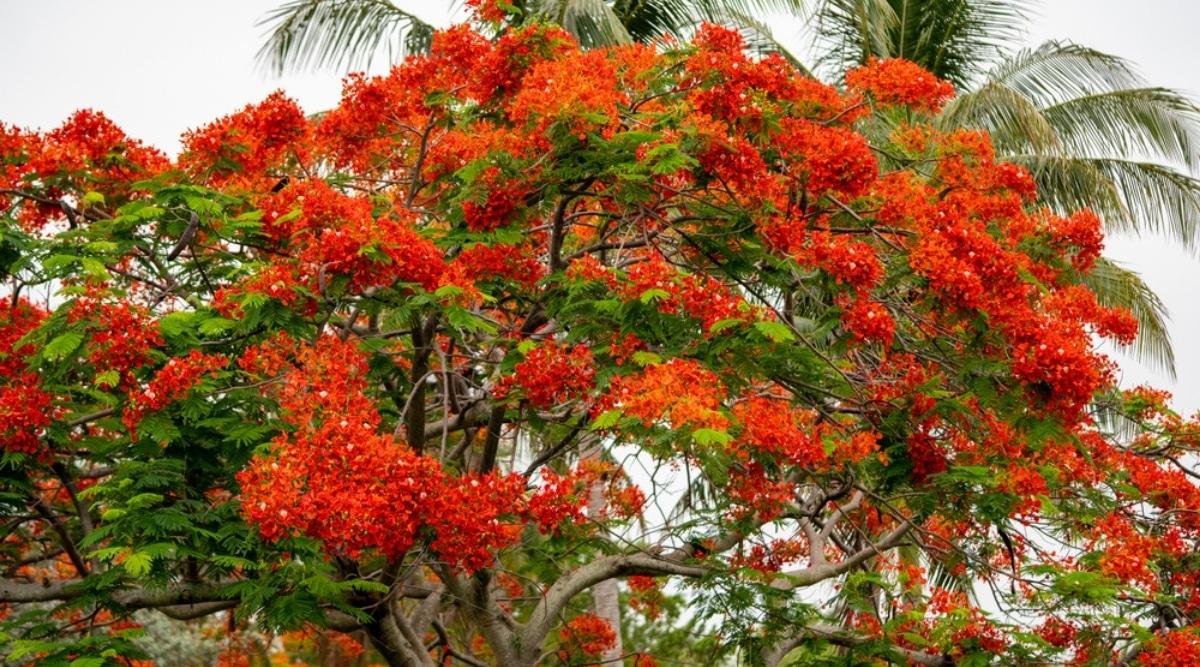
The royal Poinciana tree, also known as the flame tree, is famous for its vibrant flame-red flowers and is scientifically named Delonix regia. This flowering tree is a stunning addition to any garden, standing tall at 20 to 40 feet in height and spreading between 40 to 60 feet wide. To ensure its healthy growth, it’s essential to plant it a safe distance away from structures to allow its roots to flourish. For optimal growth, the flame tree requires at least 6 hours of full sun each day and can thrive in various soil types such as clay, loam, sand, or gravel, as long as the soil is well-drained. Regular watering throughout the spring, summer, and fall, along with proper mulching in the winter, will help maintain its health. Native to tropical regions, the flame tree thrives in warm weather conditions. Pruning the tree regularly will promote a strong and stable tree structure. The royal Poinciana tree is best suited for USDA zones 9 to 11. Consider adding this spectacular tree to your garden for a show-stopping display of vibrant red blooms.
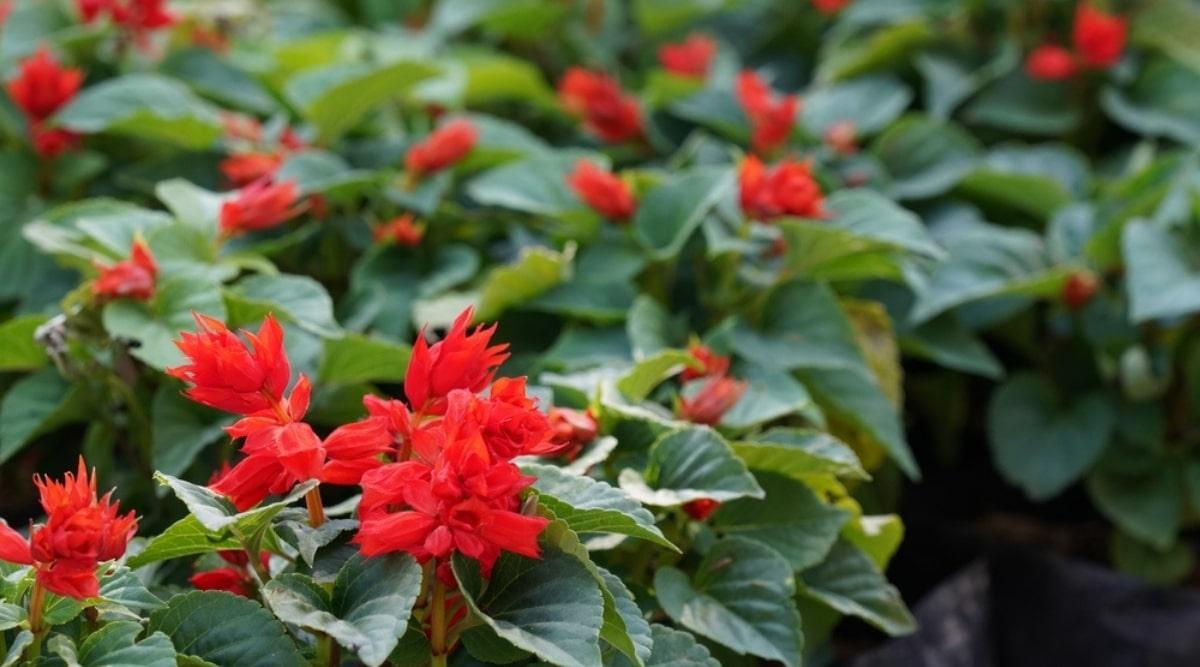
One colorful and low-growing flower choice for your garden is the salvia plant, also known scientifically as Salvia coccinea. Apart from its culinary uses as sage, salvia plants produce stunning flowers in various vibrant shades, such as red. These plants typically reach heights of 2 to 3 feet and spread 12 to 18 inches wide. In regions with milder winters, scarlet salvia plants may even self-seed. With blooms from summer to fall, salvia plants are a favorite among pollinators. For optimal growth, salvia thrives in full sun but can tolerate partial shade. They prefer slightly acidic, well-drained, fertile soil that is either dry or moist. Once established, they are drought-resistant and generally unaffected by pests, disease, or deer. Propagation can be done using seeds or through division. Ideally, salvia plants should be grown in USDA hardiness zones 8 to 10.
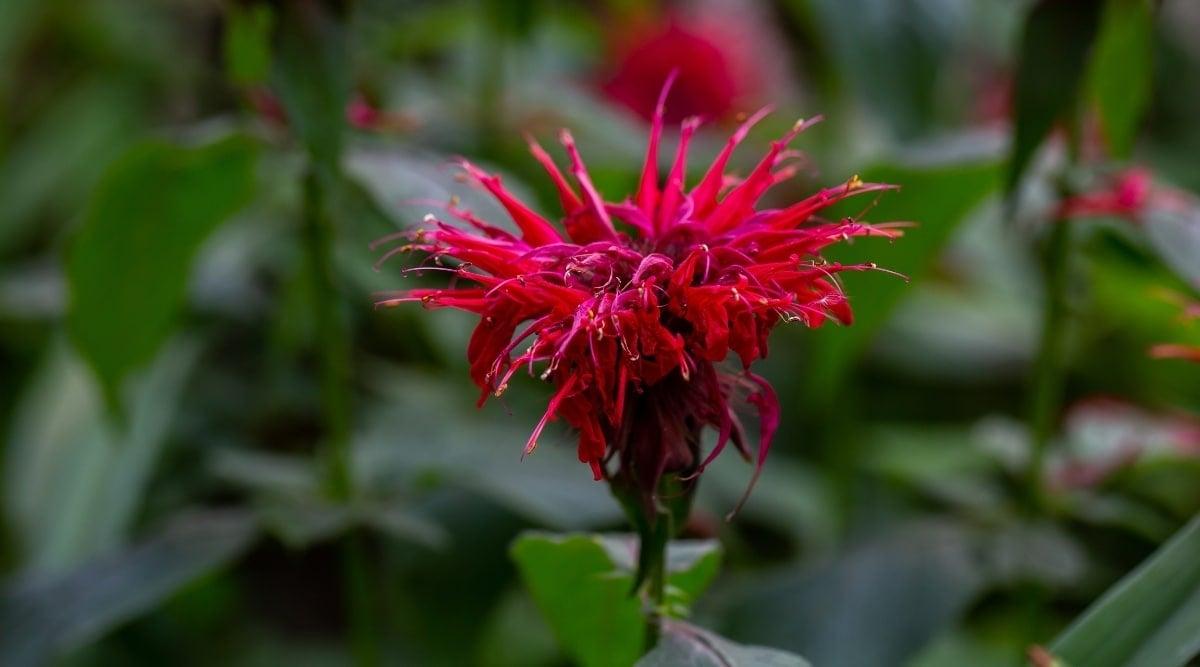
The scarlet bee balm, scientifically known as Monarda didyma, has a unique texture that can enhance the beauty of your flower beds. With its interesting shape and vibrant color, these flowers bloom from mid-summer to early fall, attracting pollinators to your garden. Growing 2 to 3 feet tall and wide, these plants thrive in full sun or partial shade, tolerating various soil types but preferring rich soil with good drainage. Keep the soil moist for optimal growth. Scarlet bee balm can be added to bouquets and flower arrangements, as its leaves have a delightful fragrance and can even be used in salads. Best suited for USDA hardiness zones 4 through 9, these plants are a wonderful addition to any garden.
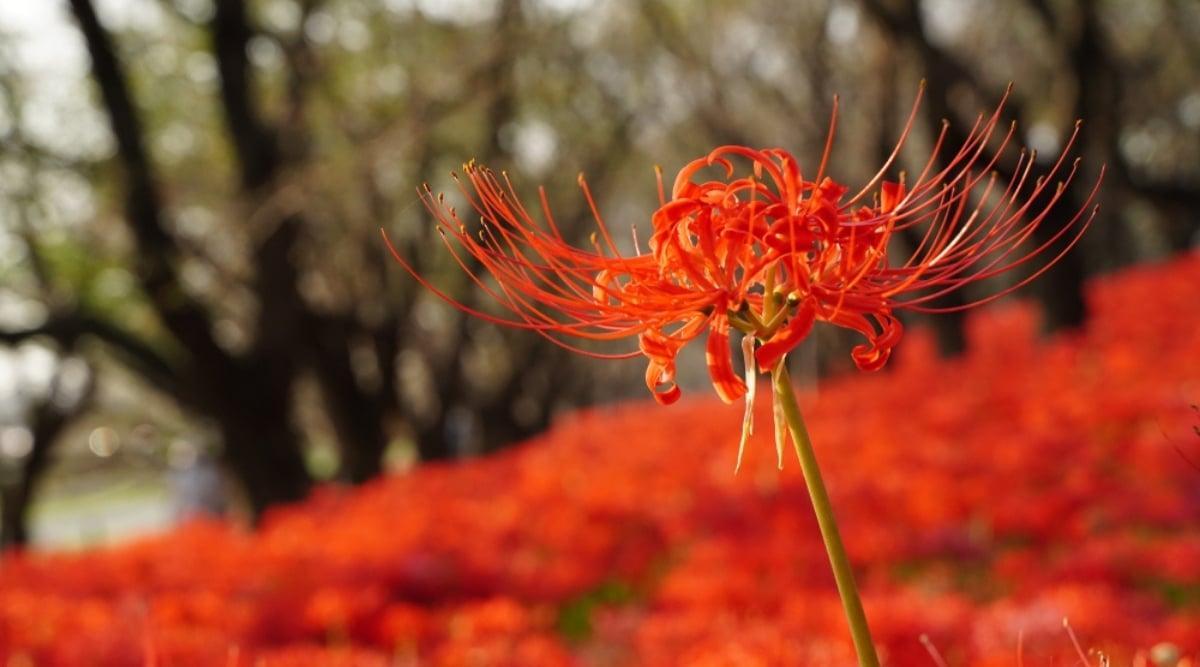
The elegant and tall flowers of the spider lily put on a stunning display in gardens. Known scientifically as Lycoris radiata, in Japanese culture, the red spider lily symbolizes death and the afterlife, blooming in the fall to represent souls transitioning to the next world. Despite its morbid connotations, these beautiful flowers are a popular tourist attraction in Japan, celebrating life even in death. The red spider lilies are truly striking, with intricate petals atop bare stems, adding a burst of color to any garden. Growing between 12 to 24 inches in height and spreading 12 to 18 inches wide, they make a striking statement in any landscape. To care for red spider lilies, provide them with partial shade for optimal flowering, although they can also tolerate full sun. They thrive in rich, well-drained soil that is medium-moist. If you live in a colder climate, ensure to mulch them well in the winter to protect their roots. These low-maintenance plants are resistant to diseases and pests, making them easy to care for. Spider lilies thrive in USDA zones 6 through 10.
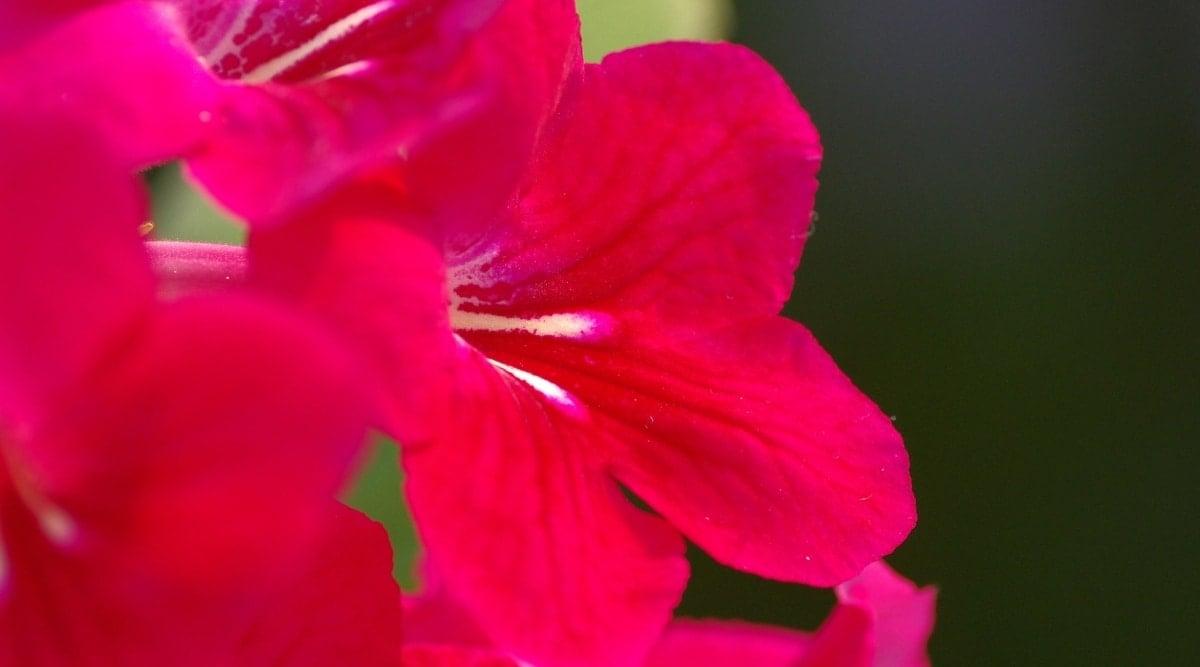
These vibrant flowers thrive both indoors as a houseplant and outdoors in gardens. Known scientifically as Streptocarpus rexii, these evergreen perennials are a delightful addition with their magenta-red blooms that stand 10 to 12 inches tall and wide. To keep them happy, provide plenty of bright, filtered light and avoid direct sunlight. Plant them in well-drained, humus-rich soil, watering regularly but allowing the soil to dry out slightly between waterings to prevent rot. Regular deadheading and bi-weekly fertilizing will encourage more blooms. Keep an eye out for pests and apply pesticides as needed. Streptocarpus does best in USDA zones 10 through 11.
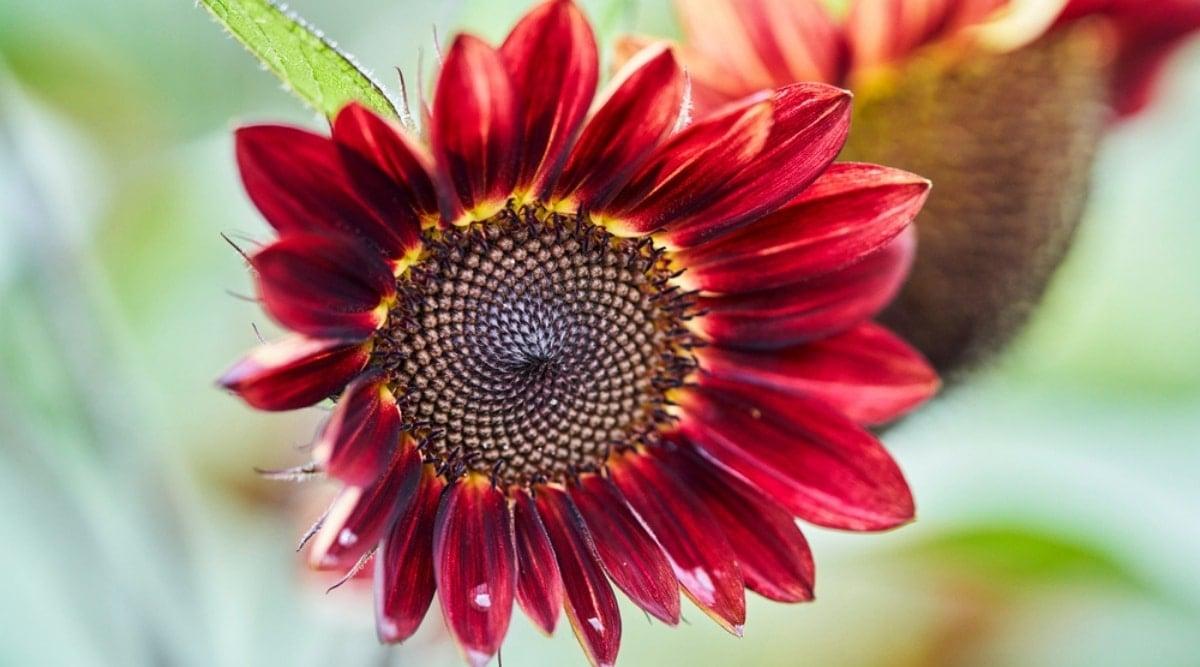
The vibrant crimson hue of these sunflowers is a rare sight compared to the usual bright and cheerful golden yellow found in most gardens. Known scientifically as Helianthus, sunflowers are famous for their iconic appearance that resembles the sun’s rays. However, not many know that these tall and delightful flowers also bloom in a stunning wine red shade, making them a great addition to any garden. In addition to their beauty, sunflowers are also excellent pollinator magnets, attracting bees and butterflies with their vibrant colors. Growing up to 5 to 6 feet tall and spreading 1 to 2 feet wide, it’s recommended to stake them to ensure they grow tall and strong. As the name suggests, sunflowers thrive in full sun and should be placed in a sunny spot to encourage the best blooms. They also prefer medium-fertile soil rich in humus that is moist yet well-drained. With minimal maintenance required, sunflowers are a great option for beginner gardeners and are happiest in USDA zones 2 through 11.
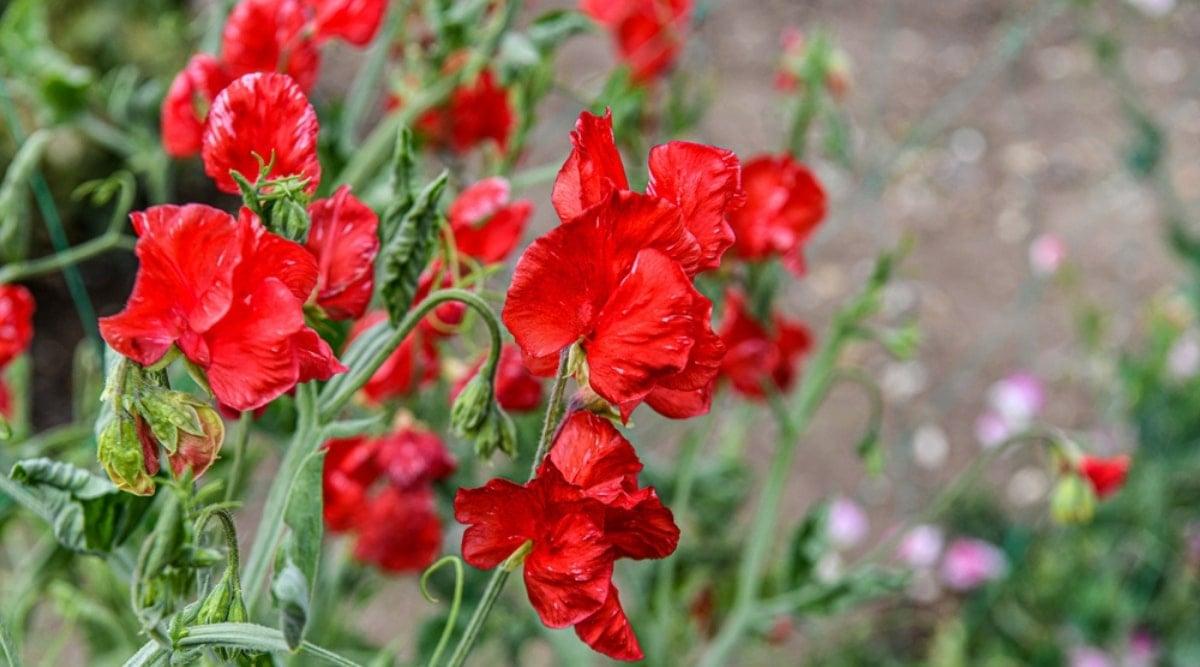
These fragrant flowers, known by their scientific name Lathyrus odoratus, are a popular choice due to their stunning beauty and delightful aroma that can fill up any garden with a pleasant scent. Sweet peas are available in a variety of colors, including a vibrant red, giving you a wide range of options to choose from. Thriving in mild and cool climates, sweet peas are at their best from spring to fall. It’s advisable to avoid growing them in hot and humid conditions. Although they prefer a cooler climate, sweet peas require ample sunlight or partial shade to bloom beautifully. They flourish in rich, fertile soil, so incorporating compost can enhance their growth. Make sure the soil maintains moderate moisture levels and drains well to prevent any potential rot. To keep their roots cool, consider mulching the soil around the plants. Planting sweet peas is also a great way to attract bees and butterflies to your garden. These lovely flowers can be cultivated in USDA hardiness zones 2 to 11.

Tulips, scientifically known as Tulipa, are a popular flower that comes in a wide range of colors, including a stunning shade of red. With over 3,000 varieties to choose from, there is no shortage of options when it comes to these beautiful blooms. Originally used as currency, tulips have now become a common and affordable flower that can be enjoyed by anyone in their garden. They typically grow to be 1-2 feet tall and spread 3-4 inches across. For the best blooms in springtime, plant your tulips in cool soil during the fall. These flowers thrive in full sun but can also tolerate partial shade as long as they receive around 4-6 hours of sunlight daily. Good garden soil with proper drainage, along with occasional misting, will keep your tulips happy. It’s important to note that tulips prefer USDA zones 3 through 8 for optimal growth. With the right care and conditions, you can enjoy the vibrant beauty of crimson tulip blooms in your garden.

You can enjoy the vibrant blooms of the beautiful Verbena plant from early summer all the way to the first frost of the year. Verbena, scientifically known as Verbena, is a hardy plant with stunning red flowers. These tender perennials can be grown as annuals in cooler climates and bloom continuously from early summer to the first frost of the fall. Verbena flowers are also a favorite among butterflies, making them a perfect addition to a butterfly garden. They typically grow anywhere from 6 to 12 inches tall and spread vigorously over an area of 18 to 24 inches wide. For optimal growth and stunning colors, make sure to plant Verbena in full sun. However, they can also thrive in partial shade. These plants are not picky about soil type as long as it is well-drained, and they can tolerate drought conditions. Using compost or a slow-release fertilizer can help keep them happy. Verbena plants are best suited for USDA zones 3 through 11. Enjoy the beauty of these flowers throughout the summer and fall seasons.
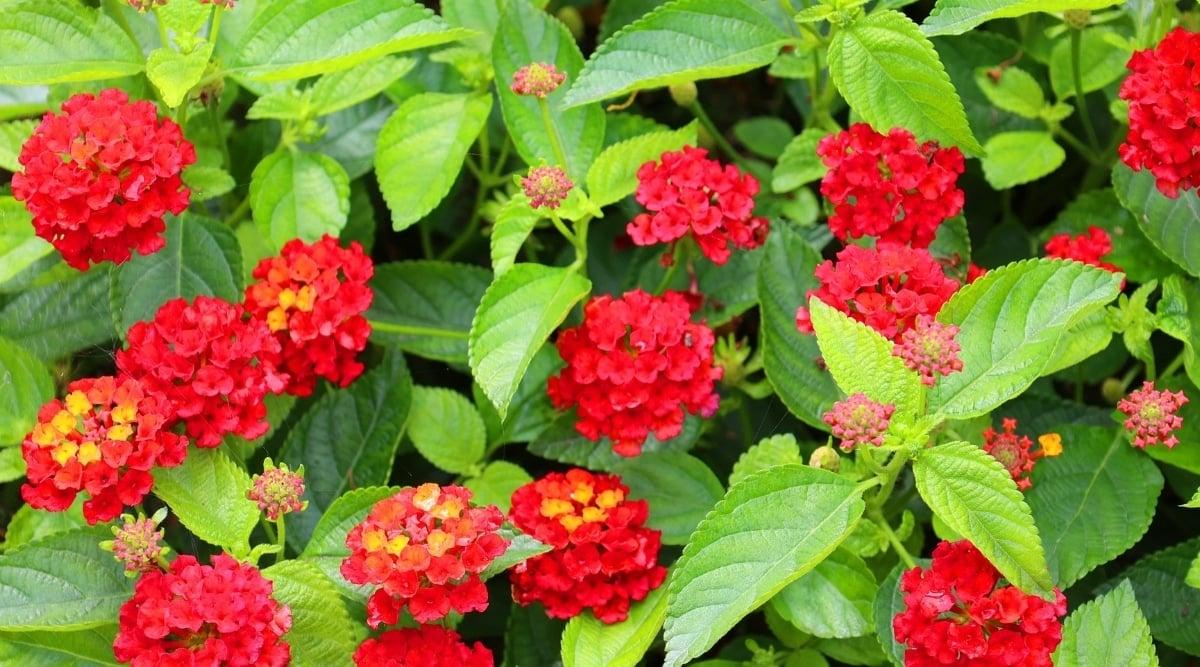
Yarrow, scientifically known as Achillea millefolium, is a lovely addition to any butterfly garden. With its fragrant and delicate flowers that come in a variety of colors, including red, yarrow blooms from late spring to late summer, providing beauty for a long period. These low-maintenance perennials are perfect for beginner gardeners as they grow up to 3 feet tall and spread 18 to 24 inches wide. For the best results, plant yarrow in full sun to achieve vibrant coloring, although they can tolerate partial shade if they receive enough sunlight in the morning. Yarrows thrive in well-drained soil with average-quality, dry-to-medium moisture. These plants are also a great way to attract butterflies to your garden, making them a must-have for pollinator-friendly spaces. Yarrow is most suitable for USDA hardiness zones 3 to 9.
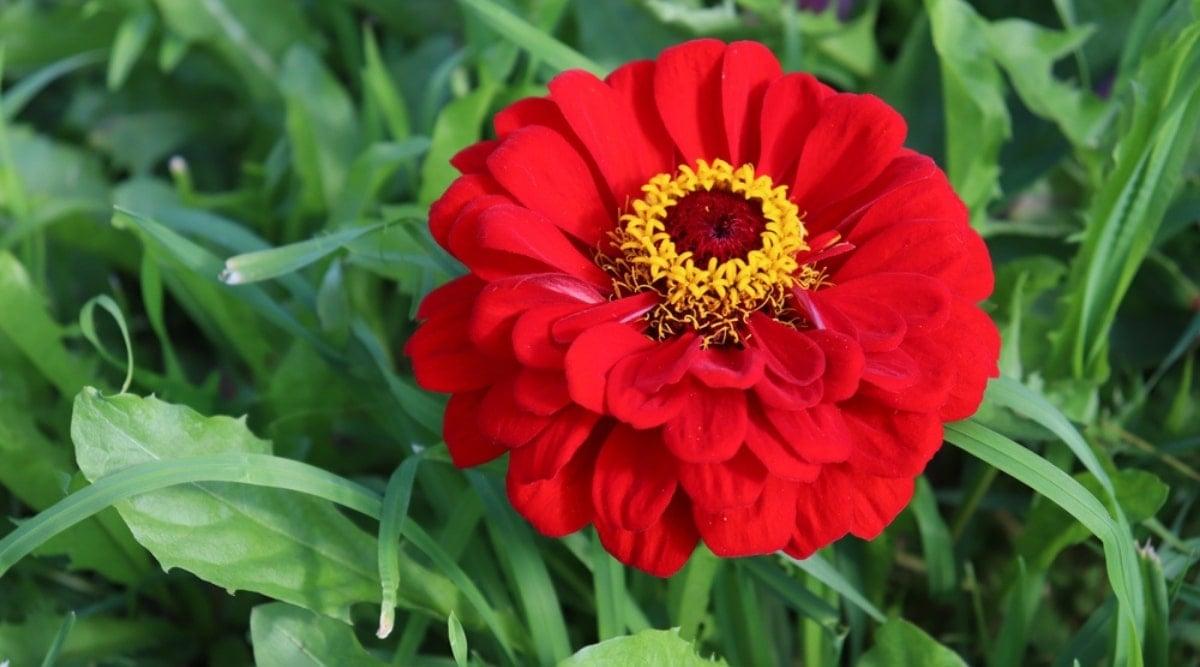
Zinnias are a fantastic choice for your garden, known for their long-lasting blooms and easy maintenance. Also called Zinnia elegans, these delightful flowers come in a variety of colors, with a vibrant red being a standout option. Their blooms last from summer to the first frost, attracting butterflies to your garden with their colorful display. These plants typically grow between 1 to 3 feet tall and spread from 6 inches to 2 feet wide, making them perfect for novice gardeners due to their straightforward care and abundant flowering. Zinnias thrive in humus-rich, well-drained soil that is consistently moist. They are resilient to heat and drought, flourishing best in full sun. While they are usually disease-resistant, be sure not to overcrowd them to prevent issues like mold and mildew. Zinnias have moderate water requirements, so water them when the soil feels dry. These flowers do best in USDA hardiness zones 2 through 11. We hope that sharing information on these stunning red flowers has inspired you to add some color to your garden. Red is a captivating color that can bring vibrancy and beauty to your outdoor space. If red isn’t your preference, consider adding other colored flowers like yellow, blue, green, or even black for a unique touch! Now that you have some insight on caring for these plants, why not introduce them to your garden and witness the transformation they bring to your landscape? If you have any queries or suggestions for your favorite red flowers, feel free to share them in the comments below!





